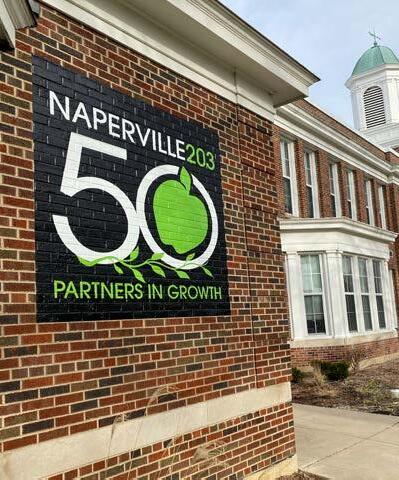A CELEBRATION OF THE LAST 25 YEARS OF NAPERVILLE COMMUNITY UNIT
SCHOOL DISTRICT 203 1997-2022


A CELEBRATION OF THE LAST 25 YEARS OF NAPERVILLE COMMUNITY UNIT
SCHOOL DISTRICT 203 1997-2022

While this book honors the last 25 years of Naperville 203, we are celebrating the first 50 years of our outstanding school district, and I am honored and privileged, as both a former history teacher and the superintendent of Naperville 203 for the last decade, to contribute to this special commemoration. Reflecting on our school district’s growth and progress, I recognize the crucial role history plays in education and society as a whole.
History has always been an educational cornerstone, offering a basis for understanding our world’s complexities. It enables us to investigate the past, scrutinize the origins of present challenges, and learn from our predecessors’ triumphs and mistakes. Similarly, our school district’s history has molded our community and emphasized the significance of ongoing learning and development.
In the past decade alone, our district has experienced remarkable expansion and advancement. From National Blue Ribbon School awards to being a Lighthouse System, an accolade granted to merely 13 districts nationwide, we have evolved into one of the largest and top-performing school districts in Illinois and the United States. We take immense satisfaction in our adaptability to the ever-changing educational landscape, while staying true to our core values.
This book not only celebrates our past, but also provides a glimpse into the future. In the coming years, we will continue to tirelessly pursue our mission to create lifelong learners by embracing bold innovation and fostering collaboration.
As we confront the challenges and opportunities ahead, let us always remember the lessons of our past. We will move forward as Partners in Growth with a deep commitment to each other and a sense of responsibility to build upon the legacy of excellence established over the past 50 years. Collectively, we will ensure our school district remains a thriving environment for students, staff, and the community for generations to come.
Before inviting you to delve into our history, I must express my gratitude to past and present Board of Education members, staff, students, families, and community partners. Thank you for your belief in our mission support, and daily embodiment of our culture. Here’s to our next 50 years!
Dan Bridges, SuperintendentWhen you ask nearly anyone why they moved to Naperville or the surrounding area, they will say “because of the schools.” Indeed, the schools and the community have a symbiotic relationship. Schools reflect the expectations of the people who learn and work in them and focus on the needs of communities they serve. High achievement of students and high expectations of our schools have played a part in every initiative and project in the District over the last 25 years – from providing each student a Chromebook or iPad and improving and modernizing our school buildings, to adding a dual language program and creating an ambitious community engagement process.
That’s the topic of this book: the stories of the last 25 years that led us to today, with schools among the top performing in the nation in a community that is known as one of the best places to live. The stories contained here are organized through contextual summaries by year and are punctuated with select nuggets of news. We not only wanted to explore the unique features and events of the time, but also some of the people of Naperville 203 whose voices and stories give us a rich picture into the history of Naperville 203. We thought it was important to uncover and share the stories that connect us all.
When I was asked to write a history on the last 25 years of Naperville 203, I was thrilled. I lived that history, as a parent, as a volunteer in the schools, as a trustee on the Naperville Education Foundation and as a communications/ public affairs consultant under the last four superintendents. I am honored to be trusted to witness and memorialize Naperville 203’s legacy.
Faith Behr

This book is made possible by a number of friends, colleagues, and current and former staff members who took the time to read the manuscript and provide invaluable suggestions. Among them are:
• Former Superintendent Dr. Alan Leis

• Former Assistant Superintendent Kitty Ryan
• Former Chief Financial Officer David Zager
Each of them helped lead many of the initiatives written about in these pages. That same spirit has characterized all of the people at District 203 who have also worked hard in support of this project:
• Superintendent Dan Bridges
• Executive Director of Communications Alex Mayster
• Director of Community Relations Jacque Clermont
• Communications and Community Relations Specialist Betty Stevenson
• Assistant to the Superintendent Susan Patton
Lastly, thank you to those who provided insight, interviews, context and perspectives as well as those who immortalized the District’s history in local, regional, and national news media and Board of Education meeting minutes.

If the first 25 years of Naperville Community Unit School District 203 were defined by steady growth, the second 25 years were defined by stability, refinement, and the evolution to a more digital, multicultural world.
Many of the same themes were repeated throughout the 50 years of the District’s history: Parents who wanted students to receive a rigorous education, educators who envisioned improvements so students could compete in a complex global society, concerns about serving a more diverse community, and challenges of aging school buildings.
On top of that were new concerns: students’ social and emotional wellbeing, keeping up with the deluge of technology, addressing crowding in some schools and a long-term projected deficit in the budget. Despite these issues, the District was attractive to parents because of its high levels of student achievement. To cement this focus on engaged student learning, the system adopted a new mission statement in 1998 that was referenced continuously during this period and is still in use today: “To educate students to be self-directed learners, collaborative workers, complex thinkers, quality producers, and community contributors.”
The galloping growth of the 70s and 80s, when the population doubled every 10 years, slowed by the year 2000. In the year 2000, the census registered 128,351 Naperville residents and 20 years later, in 2020, the census counted 149,540.
About half of Naperville was served by District 203, and the schools’ demographics mirrored its community. Over the span of 25 years, the community was becoming more diverse. In 2000, Naperville was 9% Hispanic, 8% Asian, and 3% Black. Twenty years later, those percentages grew more than 50%: 15% Hispanic, 13% Asian, and 5% Black.
College and career readiness was a concern for schools in the late 1990s. How well did the schools perform in the long term? To assess how Naperville 203 was preparing students for college and careers, the District mailed out thousands of surveys to 1989 and 1990 graduates. About 30% returned completed surveys. Results showed that 70.6% of graduates were working, 21.5% were in school, 0.8 had internships, 1.8% were “homemaking” and 2.8% were unemployed. Additionally, 32% attended Illinois state colleges, 18% attended College of DuPage and 23% attended other colleges.
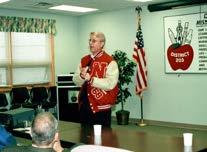
To improve communication with parents, a new phone system was installed to provide Board of Education members with voicemail.
Naperville 203 was chosen to be part of a national effort to pilot public school reform. The Standard Bearer Project was not only a framework for improvement that defined the District for years to come, but a distinct honor. The District was the only one in the state selected for the project. Put simply, the goal was to improve the quality of academic experiences
provided to students, the quality of the work students were doing, and the content of their work. In other words, school officials said, the goal is to become “as selfcritical as possible, as meaningful as possible.” Once this process was completed, the District went on to be recognized as a StandardBearer School District and served as an example to other districts seeking the same distinction.
The School Board approved a Diversity Plan that was intended to recruit more diverse employees, enlist the participation of minority parents and students, and examine the curriculum for bias and racism. The plan also addressed staff training and communication. A year later, consultants assessed the results of that plan and met with community groups such as Citizens United To Preserve Quality Education and the Diversified Parents Association, as well as the District’s Diversity Committee.
• Test scores showed that the District improved in almost every area in reading, writing, science, social science and mathematics. Especially noteworthy was a turnaround in a five-year decline in reading, and a significant increase in sixth- and 10th-grade reading and fourth-grade science. Eleventh-grade students saw significantly decreased scores in science.
• The Board approved a $3.5 million addition and renovation to Lincoln Junior High. It included a multi-purpose gymnasium area allowing space for practices and events. The addition also included locker rooms, a kitchen, teacher work area and four classrooms. The addition was planned for completion by the 1999-2000 school year.
• In satisfaction surveys, school staff and parents gave the District high marks. The surveys were conducted annually and presented to the Board of Education. In 1998, 43% of parents at all levels declared themselves “satisfied” and 30% “very satisfied” with Naperville 203. By combining “somewhat satisfied,” “satisfied,” and “very satisfied,” as well as total parent reaction at all three levels, the report reflected satisfaction in the 90th percentile in most areas.
• School staff ranked the quality of their own school’s instructional programs as very high. About 96% ranked their school
To me, it’s the most exciting thing that has occurred in 32 years as an administrator.
DR. DON WEBER, FORMER NAPERVILLE 203 SUPERINTENDENT, ON THE STANDARD BEARER PROJECT
programs as “above average” or “high.” The survey was given to staff in the spring and results were analyzed and presented in June.
• Naperville 203 received Gold Medal recognition by Expansion Management Magazine, a publication for expansion and relocation information. Naperville 203 received the highest score of 148 out of 150 possible points, tying with only four school systems nationwide. Criteria included academic scores, per-pupil spending and graduation rate levels.
• In 1998 teachers often shared a couple of phones to call parents during a free hour or after school. Board members suggested that it was time there was a phone in every teacher’s classroom. “There’s only one phone you can count on for privacy,” said Jane Stewart, a Maplebrook fourthgrade teacher. “There’s been so much push for technology in our District,” Stewart said. “Phones are technology, too.”
When the Columbine school shooting shocked the nation in 1999, Naperville 203, like school districts across the country, began to tighten security. After that, all doors were locked except the front door and volunteer greeters were deployed at the schools to check visitors in and out of the buildings.
Already, officials felt that there was adequate safety awareness at the PreK-5 level (DARE and Safety Town) and there were police liaisons in the high schools. But they believed there was a void at the junior high schools. When the Naperville Police Department received a $650,000 federal grant, they earmarked the monies for police liaisons for the junior high schools.
That year, news in Naperville was also centered on another tragedy. Marilyn Lemak, who was accused of killing her three children in their Naperville home two years before, was convicted of their murder in December of 2001. It was a murder that rocked the community and made international news in 1999 and again in 2001 when Lemak was convicted of the murders.
In January 1999 Mayor George Pradel declared Naperville “a world-class city.” The city’s developments lent credibility to the mayor’s statement. Ground was broken on a $22 million warehouse distribution center for Sears Shop at Home, Crate & Barrel opened its distribution center, and North Central College completed restoration of the historic Old Main building.
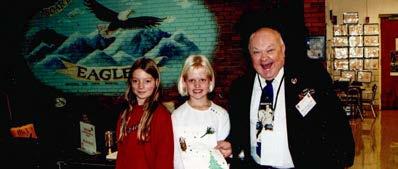
Northern Illinois University announced a satellite campus on Diehl Road, Barnes & Noble bookstore was opened, and Naperville’s first synagogue was built. The new development was in response to the rapid increase in population, and in fact, it had grown 50% in a decade.
• Naperville 203 released figures in December 1999 showing an anticipated $7.3 million education fund deficit by 2001 and an $18.4 million deficit by 2002.
Growth showed in the schools, too. Elementary enrollment in Naperville 203 was showing signs of slowing down, but high school growth had exceeded projections and was expected to top out at 3,100 students at each school.
A quick fix for the crowding, suggested by students, was to release half of the buildings a minute earlier for easier passing periods. A longer-term fix would be to lease or buy mobile units. This enrollment bubble
was not expected to last long but principals said the schools were already at maximum capacity and that every space was being used, although not always for what it was intended.
There was more change coming in the year 2000. The Board of Education initially rejected its 2000-01 budget, later passing it with the stipulation that there be $3 million in cuts.
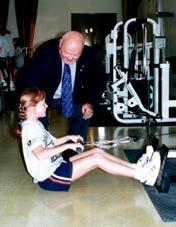
The Future Direction Committee was holding community forums and sending out surveys. They wanted to hear from taxpayers to determine if current educational programs and services were sufficient, if some should be modified or deleted, and if evolving needs were yet to be met. In other words, should there be cuts, and where, or should there be a referendum to raise taxes?
“For the most part, the community seemed to support quality education,” said Nina Menis, who chaired the group’s communications subcommittee. Parents said education quality should be maintained and teachers should keep their jobs. Some wanted fiscal integrity, some wanted a referendum. The administration looked at doubling fees to keep expenses down.
With Superintendent Dr. Donald Weber retiring at the end of June 2000, the District asked community members what they wanted in a new superintendent. They said they wanted a new leader who is collaborative but decisive with exceptional organizational, communication and fiscal management skills, and who has a proven track record at a high-performing suburban school district.
• On Jan. 1, 2000, after months of fears of Y2K, the computer bug missed the party. As the clock struck midnight and thousands of Naperville residents rang in the celebration of double zeros, nothing happened.
• A USA Today story featured Naperville 203’s physical education program, which promoted a healthy and fit lifestyle for children. Following that article, Naperville 203 joined with P.E.4LIFE Institute to develop similar ground-breaking programs in other schools. Led by Phil Lawler, the “new P.E.” which began 10 years earlier in District 203 focused on health, wellness and lifestyle management instead of a sports-based curriculum. It was a landmark program that was a model for the rest of the country.
Enrollment across the District stabilizes. In the fall, elementary schools stand to lose 162 students as fifth-graders move up through the system. Junior high schools will pick up 156 of those students. Class sizes will be reduced and the hope is that there won’t have to be a decrease in the number of teachers, and if there is, it could be accomplished through retirements or resignations.
At the same time, a U.S. Census report released in March of 2001 showed that Naperville’s population grew to 128,358, making it the fourth largest city in the state. Not only did it confirm the city’s rapid growth, but showed the community was becoming more diverse. The Hispanic population in Naperville had tripled since the last census count. The figures showed Hispanics totaled 3.2% or 4,160 in Naperville in 2000, up from 1.8% or 1,527 in 1990. There was also a steady increase in the area’s Asian population. Asians made up 9.6% of Naperville residents in 2000.
Naperville 203 continued to struggle with overcoming the deficit, but it wanted to get more creative. A committee was formed to study corporate sponsorships and figure out how much revenue the District could earn.
Already, the District had signed a five-year agreement in 1999 with American Bottling Co. to sell only beverages such as Royal Crown, Diet Rite, Snapple, and Gatorade instead of products by Pepsi or Coke. They were supposed to earn roughly $500,000 from the contract, but it brought in appreciably less.
At one point residents packed into the Naperville Municipal Center to hear administrators sketch out a plan for budget reductions. One proposed financial cut that drew particular ire was to reduce the number of classes a high school student could take, from six to five, plus P.E.. The cutback, while saving $900,000 over the next two years, could have significant effects on students, said parents and high schoolers. But the meeting turned into a forum where parents pleaded with the Board of Education not to make cuts and instead go to a referendum.
District officials said Naperville 203 needed to reduce a growing budget deficit that could top $9.5 million by the end of the 2001-02 school year.
To obtain further input on its financial issues, the Board of Education, in May, created a citizens advisory committee, called the Education for the 21st Century Committee. In October, the committee made its decision.
They said if the School Board wants to pursue a referendum in March, they need to act fast and move to put it on the ballot.
They recommended a proposal for an increase ranging from 50 to 65 cents. “If there’s a need -- and I believe there’s a need -- you have to ask people to support it,” committee member Suzyn Price told Board of Education members at the time. The Board of Education agreed and voted 6-0 to put the measure on the ballot.
Board Members Dean Reschke and Suzyn Price at a District awards event.
But a lingering concern was that a contract with teachers was not yet decided. Politically, people wondered if this would be a turn-off to
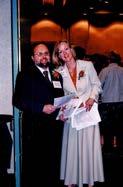
Naperville resident Jim Ondyak and Nina Menis chaired the 21st Century Committee. Here, Ondyak talks to residents about the results of the committee.
voters, who felt that the monies would go straight into the pockets of teachers. Eventually, the Board of Education passed a new three-year contract that gave teachers an average salary increase of nearly 6% each year.
If voters approved, a tax-rate increase of 50 cents would cost the owner of a house valued at $300,000 an extra $482 each year. A 65-cent increase would cost about $627. The Board of Education would land in the middle, at 53 cents.
Within days of the Board of Education agreeing in concept to the referendum, members of the community began to outline the next step. Fifty community members led by the 21st Century Committee Chairs Nina Menis and Jim Ondyak gathered at the District’s Education Center for an informational meeting.
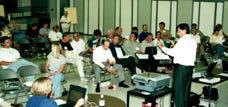
Within weeks, the working group swelled to about 150. Parent chairs headed committees such as fundraising, marketing, outreach, get-out-thevote, and others. The group, now called “Proud to Be 203” raised more than $100,000 to bring their message to voters.
They noted that while achievement was high, its finances needed some bolstering. Teacher salaries remained in the middle of similar unit districts in the area. The District’s operating cost per student was about $300 lower than the state average and the District’s instructional cost per student was slightly above the state average. Finally, the District’s property taxes, even with the increase, would still be lower than what residents living in similar houses pay in surrounding communities.
• Global learners: Naperville 203 students topped the world in science and placed sixth in math, according to results from the Third International Mathematics and Science Study.
• Average ACT scores in Naperville 203 came in at 24.9 on the 2001 State School Report Card, with more than 89% of students meeting or exceeding state learning standards.
• December 2001: Naperville 203 ratified a three-year deal with teachers that provided average annual salary increases of about 5.3%.
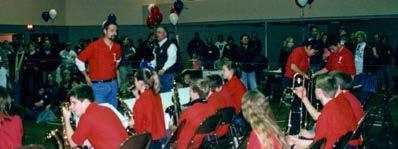
• Board of Education members authorized seeking construction bids to expand the learning centers at two of the District’s oldest and smallest elementary schools -- Ellsworth and Naper. The combined costs of the projects were $1.125 million. The learning centers were about half the size of other learning centers. One-third of the cost would come from a state construction grant.
• The year 2001 will likely be remembered most for the terrorist attacks on the United States. Extra security was put in place in the schools, offcampus activities at the high schools were canceled, and televisions were tuned in for students at North and Central in lecture halls and auditoriums. “They had a lot of questions,” said North teacher Elaine Diveley in the Naperville Sun’s Sept. 12, 2001 issue. Soon after the attacks, community members planned a memorial to honor U.S. Navy Cmdr. Dan Shanower, a 1979 Naperville Central graduate who was in the Pentagon when the third of four hijacked jets struck the building. The memorial, located next to the Naperville Municipal Center, was dedicated on Sept. 11, 2003.
During the referendum campaign, Proud to Be 203 amassed an army of hundreds to canvass frequent voters in the 203 community and to register new voters. The group held presentations at every school, enlisted realtors, took out full-page ads in the Naperville Sun newspaper, held letter-writing campaigns, and created a paid video for NCTV-17.
On March 19, District 203 asked voters to approve a tax-increase request of 53-cents per $100 of equalized assessed valuation. A total of 15,986 votes were cast in favor of the tax-increase proposal; 13,711 were cast against it. The referendum was approved with 54% voting yes and 46% voting no.
The tax-increase proposal was expected to cost the owner of a $300,000 home an additional $511 annually and generate about $15.7 million annually.
An army of volunteers worked on the referendum including marching in the St. Patrick’s Day Parade.
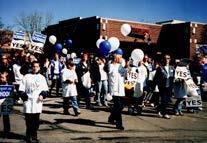
However, with a deficit on the books, money lagging from the state, and referendum money not yet flowing in, the District had a cash flow problem. In April, it borrowed
$9.8 million in tax anticipation warrants and would pay it back when it received its first property tax installment after June. Officials said residents would see an increase on their property tax bills from the referendum when the tax bills came out in June. The money would generate about $15 million more a year once fully implemented. As promised, it would be used to maintain programs and return the District to financial stability by the end of the 2005-06 school year.
The Edward Cardiovascular Institute has been a business partner with Naperville 203 for 13 years and has developed programs for students that emphasize lifelong cardiovascular health and fitness. These programs have become the basis of the Naperville 203 physical education curriculum, which has been recognized as a model for the nation by the Centers for Disease Control. Cholesterol levels in Naperville 203 students have gradually declined, and at least six heart conditions in students have been detected as a result of heart monitors implemented by ECI.
• The 2002 School Report Card showed strong performance again this year. Average ACT exam scores in Naperville 203 came in at 24.4, a halfpoint drop from last year, and 86% of all students were meeting or exceeding state learning standards, compared with the state average of 60%.
• Kennedy Junior High was one of 170 schools nationwide, and one of only three in Illinois, to earn a National Blue Ribbon Award of Excellence from the U.S. Department of Education.
• A follow-up survey and analysis of voters was conducted. It showed that there were roughly five groups of voters: Education Boosters (19%); Skeptics (18%); Skeptics redux (19%); School personnel supporters (25%); and Plant and equipment supporters (19%). The Board of Education said it wanted to learn more about why people supported or didn’t support the referendum, and wanted to talk to people about their concerns and issues with the District.

As part of Naperville 203’s professional learning experience, Kennedy Junior High teacher Louise Huffman attended a National Science Teachers Association (NSTA) regional conference and was inspired by polar explorer Will Steger.
After his talk, Huffman was hooked on what she referred to as the “highest, driest, windiest, coldest, cleanest place on earth.” She presented newly created polar science curriculum at the Antarctic Institute at Hamline University in Minnesota, then applied for and was accepted to attend a trip of a lifetime. She was chosen as one of 12 teachers nationwide to participate in Teachers Experiencing Antarctica and the Arctic in 2002.
“Naperville was a great place to teach,” she said recently. “They gave teachers the freedom to explore and grow.” The three-month study and her substitute were paid for by the National Science Foundation (NSF).
On the excursion, Huffman stayed near McMurdo Station in the Dry Valleys, on the southern edge of Antarctica and helped scientists by mapping streams and studying algae, moss, and other life forms that live in small streams that trickle from the mountains during the summer in Taylor and Wright Valleys. She shared her work with her Naperville students daily in an online journal and connected them with many of the scientists working near McMurdo that season so the students could ask questions of the experts. Huffman and her teaching team’s enthusiasm for the excursion spread to the entire school, which held an Antarctica Day, and eventually to the entire district.
Naperville 203 had a volunteer greeter program, usually made up of parents. But in one case, at Lincoln Junior High, there was a special retiree, who was beloved by students. Louis Trierweiler used to come early to his weekly post to greet and check in visitors before the school had its security check-in system.
He had a ready smile and always had candy and cookies on hand to give to students and staff who stopped at his station. He always carried a pocketful of coins so students could make change for a single or a $5 bill so they could buy something from the vending machines. Trierweiler was one of Naperville 203’s HURRAH (Happy, Upbeat Retirees [& other] Residents Actively Helping) volunteers. In addition to his job as a greeter, he could be found at the Springbrook Golf Course working with Lincoln Junior High’s intramural golf team.

“I’VE taught generations of students,” said Sally Pentecost in a June 14, 2002 issue of the Naperville Sun Newspaper. “The kids I’ve taught are all over this community, they’re at McDonald’s, they’re stock brokers, they’re bankers.”
She also influenced some of their careers. One former student told her how a newspaper class Pentecost taught helped her choose journalism as a career path. Another young boy created a computer-generated synthesizer as part of an independent study in one of her classes. Years later, Pentecost ran into that boy’s mother, who informed her that the former student’s class presentation led to him conducting research that eventually earned him a Nobel Prize.
“You don’t know, sometimes, the influence you have on kids,” Pentecost said.
There were some big changes in administrative staff at the start of the school year. The District welcomed new Superintendent Alan Leis, who had served as deputy superintendent for Fairfax County Public Schools in Virginia. He followed the retirement of superintendent Dr. Donald Weber. Jim Caudill began his new role as principal of Naperville Central High School and Tom Paulsen, former principal of Naperville Central, began his new position as associate superintendent of secondary education.
For a new superintendent, stakeholders had said they wanted a superintendent with superior collaborative and communication skills. In the initial years of Leis’ tenure, those skills were put to the test. First, there was a controversy about an alleged over-collection from the 2002 tax-rate increase. About the same time and a few hours before the first day of school was to start, the District averted a teachers’ strike. Then, there were concerns about the age and condition of the buildings.

Parent concern started to swell about the inadequacy of the swimming pool at Naperville North. A change in official IHSA rules had forced a change in the pool by requiring “all pools under four feet to remove their diving blocks.” Parents complained that swim teams at North were put at a great disadvantage both in competition and safety compared to all other swim programs in the state. Competitions could no longer be held at Naperville North and parents felt that the team had suffered as a result.
• In late fall, the District launched a new email notification system that allowed parents and residents to stay informed about what was going on in the District. Called Talk 203, the system allowed people to register
Naperville North’s new pool would eventually be dedicated in 2009, following construction.
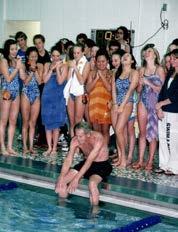
and tailor what type of information they would like to receive from the school district.
• After months of negotiations and following mediation, the 540-member Naperville Education Support Professionals Association (NESPA) filed an intent to strike notice with the state. The issues were health insurance and salaries. Later, the two sides were able to go back to the table without incident and agree to a new contract.
• A virus infected the schools’ 5,000 computers, putting the system down for a few days. The bug arrived by email and each computer had to be “cleaned” and a patch had to be installed to prevent further damage. The problem, though annoying, didn’t disrupt any services such as grade distribution. Officials also said no private student data was infiltrated.

In March students at North and Central staged a walkout to protest the pending U.S. war on Iraq. Said then-North student Sara Ellena, “Sometimes you have to break a rule or law to prove a point.” Their walk mirrored an anti-war rally at the Federal Plaza in Chicago and elsewhere throughout the U.S. In all, about 150 North students joined the protest. Dhruv Boddupalli, a senior at Naperville North who was helping Ellena organize the event, told the Naperville Sun that he thought this was a good way to bring awareness to the subject and to show that students care about global issues. “My hope is for people who’ve never been to a rally to learn of other social causes,” said Boddupalli in the Sun. The group also asked Howard Zinn to speak at North, which he did, and organized a food drive and a student/teacher debate on the war.
Nearly 20 years later, Boddupalli recalled that time was the beginning of his interest in social change. “What I realized is that even though we weren’t successful in that instance, we can mobilize and come together and address larger issues.” He and his fellow Naperville North protesters were suspended from school for a day for their activities and his parents learned of his indiscretion when a broadcast reporter called his home. “They were proud of me but at the same time it was like ‘What the heck were you doing?’” he recounted.
He went on to MIT, graduating in chemical-biological engineering, earned a medical degree from Stanford Medical School and completed a residency at Beth Israel Deaconess Medical Center, part of the Harvard University teaching hospitals. His interests then turned to technology, where he founded and worked at multiple startups. He was an early employee of Zipline, a U.S. startup building drone logistics. Boddupalli helped the company grow in Sub-Saharan Africa where Zipline delivered blood products, medicines, and health supplies to facilities within minutes in a 50-mile radius. Zipline has since expanded to seven more countries, including the U.S., Japan and Ukraine. After practicing medicine in San Francisco, he returned to Naperville with his wife and two children. He practices internal medicine at the University of Chicago Medical Center and works at a health care startup.
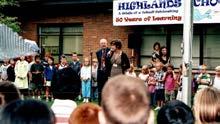
Highlands Elementary School is known for its family and community involvement. It has activities for everyone involved in the school -- parent coffees with the principal, dad’s breakfast, surveys, family career nights and family math, science and literacy nights. The school has also created a Building Leadership Team and business partnerships. All the activities are tied into the school improvement plan, which is also tied into the curriculum.
Because of this, it is a perennial winner of the Partnership School Award from the National Network of Partnership Schools at Johns Hopkins University. In 2003, Highlands was one of four schools nationwide honored for developing and sustaining comprehensive programs of school, family and community partnerships. It was the fourth year of winning the award. The driving force behind Highlands’ success in this area was Principal Susan Stuckey. “Susan’s welcoming personality, deep understanding of school leadership and exceptional organizational skills made the strong ties she forged with her parents and the extended business community seem effortless,” said Kitty Ryan, former assistant superintendent.
Naperville Central High School’s enrollment was growing. Its freshmen class was bigger this year and its special education needs were greater. In 2003 enrollment grew by 40 and this school year it was expected to grow by another 40 students. School officials said last year was problematic, with every space taken up with classes, and some areas were inappropriate
spaces for classrooms. For example, a tech class was held in a math classroom. So, with no more room, and certainly no more flexible space, the plan was to place two more mobile classrooms on the grounds this year. That brought the total number of mobiles at the high school to eight. The official enrollment count in 2004 was 3,111, and 797 of those were freshmen. Naperville North’s projected enrollment was slightly less at 3,026, and 800 of those were incoming freshmen.
With the U.S. facing the Great Recession, Naperville 203 continued to have financial challenges, despite the recent referendum. Projections showed that the District was falling short of its goal to cut the deficit by 2006. Officials said that investment returns were dropping because interest rates were low and continuing to decline while at the same time costs, such as employee benefits, continued to rise dramatically. Adding to that, officials cited substantial facilities and equipment needs. As a partial solution to the unforeseen financial difficulties, the Board of Education looked to sell two pieces of property to help bolster their revenues - the Hobson School property now operated by Hobson Cooperative Nursery School and the Walnut Ridge property. The Walnut Ridge property faced heavy opposition from neighbors, however, who formed a community group called Save a Valuable Environment (SAVE).
Other issues were on the horizon. The District anticipated a significant number of teacher retirements and an increased need to address students’ social-emotional development.
Superintendent Alan Leis proved to be a popular superintendent, in part because of his intellect and his formidable communication skills. He formed a Superintendent’s Parents Advisory Council to get feedback from parents and to bounce off ideas to help find solutions to these pressing issues. He asked each school support organization, HURRAH (retiree volunteers) and the Naperville Education Foundation to select a representative to sit on the committee.
“We’ve got several issues and I’d like to have an ongoing group both to share information (with) and to listen to, to make sure that at least I’m hearing where the community is,” he said at the time.
• With more printing needs than ever, the District moved its document services center from underneath Naperville Central’s football stadium into the 21st century and into rented space at 710 W. Fifth Ave., just south of Naperville North. The 3,500 square foot space allows teachers to scan documents and send them to the print shop for high-speed printing and send them back to the schools within 24 hours.
• The new fad of dancing, called grinding, sounded some alarm bells for parents, administrators and dance chaperones at both high schools. The suggestive dancing was the talk of whether to create new policies or new school rules about what is considered lewd on the dance floor.
• School boards don’t often get into the minutiae of what brands are in a school’s pop machine but Naperville 203’s Board of Education brought up the topic when the superintendent raised the concern of selling soda to high school students with high fructose corn syrup. The Board of Education debated the issue for months and finally settled on a vote 5-2 to stop selling carbonated soft drinks with the sweet substance, and instead sell milk, 100% fruit juice and water in the vending machines and at lunch lines. It was yet another signal 25
that the Board of Education wanted to provide a healthier environment for students.
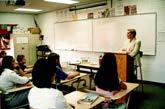
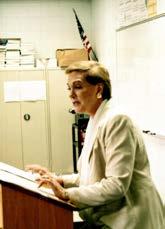 Julie Andrews met with budding junior high writers as part of her visit to Naperville thanks to a partnership with Anderson’s Bookshop. She was promoting her children’s book “Dragon: Hound of Honor,” a murder mystery that she wrote with her daughter, Emma Walton Hamilton.
Julie Andrews met with budding junior high writers as part of her visit to Naperville thanks to a partnership with Anderson’s Bookshop. She was promoting her children’s book “Dragon: Hound of Honor,” a murder mystery that she wrote with her daughter, Emma Walton Hamilton.
• After years of the District’s efforts to recruit and retain minority employees, there had been little to no change to the District’s demographic profile over the past five years. The Diversity Committee’s report cited barriers to that progress and outlined potential solutions.
Naperville 203 employed 41 minority teachers in 2002-03 or 3.2% of the District’s teacher population. That contrasts with the District’s minority student population which has grown slightly each year, from 16% to 19%, in 2004.
A November 2005 report showed that the District exceeded its 2002 referendum revenue projections by an estimated $20.8 million. The goal of the referendum was to maintain the District’s programs while cutting its $16.5 million deficit that would have grown to $65 million in the next 3-4 years without a referendum. The tax rate – set by the County Clerk – is determined by the total amount of property taxes collected by a district in the prior year and multiplying it by the current year’s inflation rate, and then dividing that number by the difference between the value of its tax base and the value of new construction within it that year.
But critics challenged the way the referendum tax levy was structured, arguing that a phased-in tax rate increase is illegal and argued that the $200 million of property taxes collected in DuPage County that year should be overturned. Administrators and the Board of Education countered that assertion and said under current law, a school district has two choices in its referendum design: a single-year, sizable increase in the tax rate, or a multiyear, more gradual increase with most districts choosing the latter. The Board of Education noted it was critical that the District not receive more than either voters or the law authorized.
Later in the spring of 2006, the Board of Education debated whether to issue a refund check to homeowners or abate the levy. If issued, homes valued between $300,000 and $450,000 would receive refund checks roughly between $212 and $324. Another option proposed by a School Board member was to abate $4.4 million from the upcoming levy.
The issue was addressed after a successful building referendum when the Board of Education abated the bond levy that was authorized by the referendum.
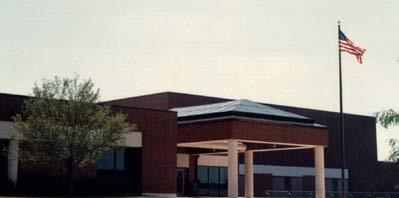
Another difficult issue was the aging and outdated schools. Some parents reported that when they first walked into Naperville Central, they thought there was a brownout, that’s how dark the school was. Then they saw a bucket on the ground catching rain. But there were many more deficiencies. Naperville Central was also short on space. As a result of the facilities concerns, consultants were brought in to assess all the District’s facilities. They said Central in particular needed 13 additional classrooms and more space for small-group instruction, special education instruction, offices and storage.
Parking and traffic were a large problem at both high schools, but overall, Naperville Central, an older school, was far more deficient than Naperville North. Multiple additions at NCHS meant that passing periods were crowded, circulation was haphazard, and departments were splintered. Many areas such as science labs were woefully outdated. The school was in such dire need of updating that consultants said all options should be on the table – rebuilding portions of the school or tearing down the entire school and rebuilding a new facility.
Junior highs had similar needs for small-group instructional space, and three of them needed a large space for group instruction. Elementaries faced similar challenges for large-group multi-purpose space. It was always a problem to juggle P.E. classes with lunch, music, and concerts in the same gymnasium.
Lincoln Junior High rivaled Naperville Central as one of the most deficient facilities in the District. It was built as a K-8 school and was retrofitted as a junior high.
Mill Street Elementary was singled out as problematic and needed to be expanded. Consultants also pointed out that decisions needed to be made about the location of potential new and growing
programs such as hot lunch, early childhood, and all-day kindergarten as part of the facility study.
While enrollment was flattening out, space was needed for specialized programs such as special education, English Language Learners, bilingual services and gifted programs. Two mobile classrooms would be added at Mill, and four mobile classrooms would be added to Kennedy to keep class sizes within the required range.
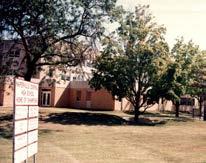
“The reality is that our overall enrollment is going down, but the diversity of the needs of the kids we are serving is increasing,” Superintendent Alan Leis said at the time.
A 30-member citizens committee was tasked with prioritizing a plan to repair and upgrade the 21 existing buildings. It reported to the Board of Education in June 2005. It was the beginning of a long process to map out the needs of the aging infrastructure and educate the public on the limitations of the facilities.
In the summer of 2005, tensions were again ramping up between the teachers union and the Board of Education over contract talks. Contract negotiations between the Naperville 203 Board of Education and the Naperville Unit Education Association began in November of 2004, but they didn’t end until mere hours before the first day of classes in August 2005.
My grandma and grandpa met at Naperville High School [before it was Naperville Central High School], and my grandpa was head over heels for my grandma. He would get up from his desk to sharpen his pencil over and over, just to get a better look at her in class. Finally, after convincing one of my grandma’s friends that he was a good guy, my grandma agreed to go out with him. They were married happily until my grandma passed last year. My mom and dad both went through District 203 schools too. The district is an important part of my family history.
The timing – late August –meant that Friday night’s first football games for the Redhawks and Huskies were in limbo. That meant tempers and emotions were high.
Members of the media and NCHS football team members were standing outside the District office at 2:15 a.m. Aug. 23, 2005, when Debbie Shipley, school board vice president, and Dave Griffith, NUEA president, stepped outside and announced the two sides had reached an agreement.
Terms of the three-year contract provided teachers with average annual salary increases of 5.2%. The union had sought increases averaging 5.5% and the Board of Education had offered as high as 4.99%. Just a few days earlier, in a vote of 937-77, teachers rejected the board’s 4.99% offer and voted in favor of a strike if a better deal couldn’t be reached
by the first day of school. Teachers eventually approved the later deal by 1,088-27.
After these contentious negotiations, two years later, with more than a year left in the teachers’ contract, the Naperville 203 Board of Education and the teachers union reached an agreement on a two-year extension.
It covered the 2008-09 and 2009-10 school years and allowed for either side to reopen negotiations for the second year of the agreement. It also made for smooth openings of schools in the coming two years.
The Walnut Ridge property continued to be an issue for the next year. In February 2005, the Board of Education voted to place the 11 acres of wooded property adjacent to Walnut Ridge subdivision on the market and in April agreed to sell the parcel for $5.65 million to JTJ Consulting and Real Estate, the highest bidder for the property.
Save A Valuable Environment (SAVE) and its partners, The Conservation Foundation, the Naperville Park District and the Will County Forest Preserve District, submitted a $3.8 million bid for the property, which was the District’s minimum asking price. But the District felt that it was incumbent to obtain more for the property. The bidder allowed the Board of Education to place a restrictive covenant that would help preserve trees for the property owners in the Walnut Ridge subdivision. That covenant states that some or all of the trees within 15 feet of the west and south borders of the property would be conserved. JTJ said it planned to build about 20 to 25 8,000-square-foot homes on the property, which, when completed, would mean six of the 11 acres would be developed.
• ACT scores have nearly climbed back to where they were before the state mandated that all high school juniors take the test as part of the Prairie State Achievement Exam. The District’s total score was up from 24.5 in 2003 to 24.7 in 2004. North’s overall score was up that same increment -- from 24.5 to 24.7 -- while Central’s held steady at 24.6, the same composite score it received last year. For Naperville 203, there’s good news in those scores, because they were approaching the level when only college-bound students took the exam.
• New teachers and staff could be found at the Naperville Police station these days after new legislation was passed in August, requiring all new employees of a school district to submit to a fingerprint-based background check. Districts 203 and 204 together purchased an electronic fingerprinting machine, to be housed at the police station, to be used for the new requirement. The check searched Illinois records and the FBI database for felony convictions.
• In October, U.S. Senate candidate Barack Obama visited Naperville Central and Naperville North high schools while campaigning, leaning heavily on portions of the keynote address he delivered during the Democratic National Convention. Alan Keyes, Obama’s Republican counterpart in the U.S. Senate campaign, was scheduled to visit both high schools, but canceled the week of his planned appearance.
• The Naperville Education Foundation provided seed money for the establishment of after-school Study Skills Academies at all 14 district elementary schools for fourth- and fifth-graders. The academies are designed to develop constructive study habits in students identified as needing academic help outside the classroom.
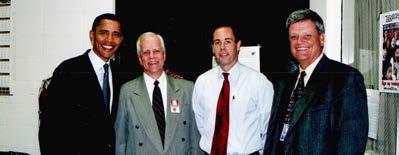
• High school students have long complained about the timing of finals after winter break, meaning that the break isn’t restful or restorative but a stressful time of studying. The District began studying whether to change its calendar and start school earlier in August so that high school students can finish the first semester before winter vacation. An online survey showed that four out of seven people surveyed approved of the plan. So beginning with the 2006-07 school year, the Board of Education decided to start school earlier than it had traditionally. It would necessitate ending school in May, and in some years starting school in mid-August. It was a decision that has stuck for future generations.
• The website was again overhauled and the address changed to the more user-friendly naperville203.org instead of the forgetful www.ncusd203.org. No longer will updates funnel down to one website manager to post. Now departments will be responsible for providing timely updates to their pages.
Much of 2006 was focused on the state of the school facilities. A community task force, formed in the spring, agreed with the consultants’ assessment and in November 2006 recommended that the Board of Education spend $100 million to renovate and repair the facilities. The biggest challenge they noted was Naperville Central, which they agreed needed a complete overhaul to the tune of $72 million. Another option, which the task force earlier had favored, was to tear down the school and rebuild it from the ground up for about $150 million. They also presented a pared-down plan to remodel the school for $40 million.
Also on the list was expanding Mill Street Elementary, whose enrollment had swelled recently to 800 students but could only hold 600 students. Another need was to build an early childhood education center to accommodate all district-enrolled preschool students. Repairs on the pool were needed at North due to new state competition guidelines for diving blocks. Other projects were on the docket as well. The community was heavily involved in the process, attending question-and-answer sessions and touring Naperville Central.
A later 2007 survey showed that respondents ranked the facilities as a “hot button” issue. While Naperville School District 203 received high marks overall on an online school perception survey compared with nine other high-performing schools in the country, when it came to facilities, it fell way short.
The facilities plan could not be funded through the regular budget and would require a voter-approved referendum to issue bonds (debt) and raise the tax rate.
Though the District ranked first or second in academic and other categories, respondents at the elementary level gave scores that resulted in a sixthplace ranking for facilities. Those at the junior high level tallied a seventhplace ranking, and those at the high school level gave facilities a ninth-place ranking out of nine districts. “The people that live and work and use those buildings realize that they need to be improved, and I think that that’s really important,” Board of Education Vice President Susan Crotty said at the time.
• The District’s P.E. program was again in the news, this time for a landmark study partnering with PE4LIFE in reworking schedules for freshmen literacy students so they would start the day with exercise. The 80 freshmen, identified as needing more support in reading, were enrolled in Zero Hour P.E., before the first period. Subsequent testing in vocabulary and comprehension showed remarkable results. In vocabulary, the literacy students taking PE during the middle of the day improved 6.7% or 0.6 of a grade level. Students taking Zero Hour P.E. improved 11.6% or one grade level. The study helped launch a national movement and was highlighted in a 2008 book by psychiatrist Dr. John J. Ratey. In the book he notes that “What Naperville provides is a powerful case study on how aerobic activity can transform not only the body but also the mind,” he wrote in his book on page 19. “It also happens to be a wonderful template for reshaping our society.”
• Naperville was named the Second Best Place to Live by Money Magazine in 2006. It moved up a slot from No. 3 in 2005. Mayor George Pradel noted that congratulations poured in again, noting that Naperville was truly a gem in the suburbs of Chicago and the State of Illinois.
• With security continuing to be a top priority, the District made plans in October to purchase buzzer and camera entry systems for every elementary and junior high school. Until they’re installed, front-door security personnel will be hired to secure the front doors. The cost will be $120,000-$140,000.
• First-grade teacher at Ranch View Elementary Lynn Rule was one of 10 finalists for the 2006-07 Illinois Teacher of the Year Award. The next year, Patricia Adamatis, an adaptive physical education teacher at Naperville Central High School, was named one of eight finalists for 2007-08 Illinois Teacher of the Year.
Allie Ciha, a 2014 NCHS graduate, studied Mandarin at Central and continued her studies in college and now works for Sony Music Global Finance covering Asian territories. She is pictured here in Chiang Mai, Thailand, while studying abroad in college in May 2017.

Beginning with the 2006-07 school year, for the first time in Naperville 203, Mandarin Chinese was offered as a foreign language at the two high schools. The language was the first non-Western language offered in the District, the rationale being that it is significant in the global marketplace and also 15% of the world speaks Mandarin. In addition, more than 1,000 students take Chinese through private instruction. Enrollment was strong and allowed three sections to be held between the two high schools. Anecdotally, students who took the language were not only those whose parents were Chinese or were of Chinese descent, but those without Chinese ancestry who were interested in the language.
“Learning Mandarin was a highlight for me,” said Naperville Central grad Allie Ciha, who graduated in 2014. She took private lessons in junior high, two years in high school and two more years in college, graduating in Finance from Indiana University with a co-major in International Studies.
“Learning the Chinese language and the culture was a big factor in getting hired at Sony Music,” Ciha said. She now works in Manhattan for Sony Music’s Global Finance Team covering the Asian territories. “Cultural understanding and awareness are imperative if you want to work in a global setting,” she said.
• Elementary students were treated to hot lunches at school this school year. The rationale was that good nutrition and achievement were linked, plus with solid participation rates, the program would pay for itself. An earlier pilot program involving a handful of elementary schools proved successful so the Board of Education voted to extend the midday meal program to all elementary schools. Funding came from state and federal subsidies and user fees. However, start-up costs to outfit a centralized kitchen – most schools don’t have full kitchen facilities – were $370,000, plus $50,000 for a yearly lease.
• When the 2006-07 school year ended, so did class rank calculations on high school transcripts. The Board of Education’s decision came after months of debate by students, parents, teachers, surveys and
Here, parent volunteers and Young Hearts for Life workers conduct cardiac screenings on D203 freshmen.
focus groups. Proponents of ending class rank say that students are often penalized for class rank because there are so many high-achieving students in Naperville 203 and that students may not take a “regular” non-weighted class like music or technology that would make them more “well-rounded.”
• In a unique pilot program, 2,000 incoming freshmen were screened for a rare but deadly heart condition that can affect young athletes. The cardiac screening program, called Young Hearts for Life (YHFL), was conducted by the Midwest Heart Foundation. YHFL trained dozens of Home & School volunteers to perform the screenings in the locker rooms of Central and North, identifying a handful of teens and recommending them for further testing with their doctors. The program has since been spread to other schools throughout the Chicago region.
• In May 2006, the Board of Education approved a new contract with bus drivers, which meant that the District’s 155 bus drivers wouldn’t be outsourced. The agreement followed a protest at an earlier Board of Education meeting. The School Board had been considering six bids for transportation services. Yet, while bus drivers approved the new contract, they weren’t happy with a provision that called for a reduction in the hourly rate of pay.
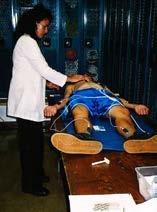
Longtime parent volunteer turned staff member, Maureen Dvorak, was honored on WGN Radio host Spike O’Dell’s “Hometown Hero” segment during his Naperville broadcast on June 23, 2006. The nomination, limited to 100 words, noted that Dvorak “had a smile and a kind word for everyone.” A single mom of two boys, Dvorak was a force both as a volunteer and a staff member. O’Dell noted that Dvorak was a big supporter of Naperville Operation Support
Maureen Dvorak is often the first person families meet when they enroll their child in Naperville School District 203. Here she is with her team, pictured at far right.
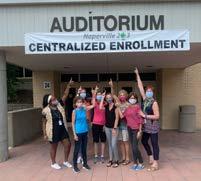
Our Troops, organized 2,000 volunteers during the successful 2002 referendum, and was chairing the mammoth NCHS All-Night Senior Party. Dvorak also completed the Naperville Citizen’s Academy course and served on the Sister Cities Commission - all without missing a single one of her sons’ ballgames. In the District office, Dvorak organized large events for the Community Relations Office and served as Assistant to the Naperville Education Foundation before being promoted to Manager of Enrollment. “I was so touched by the WGN Hometown Hero award,” Dvorak said. “Especially because it came on the same day that my dad passed away. To be considered a Hometown Hero in Naperville where ‘heroes’ abound was truly an honor.”
Now, she serves as School Services Manager at Naperville District 203 overseeing the process of enrolling thousands of new families who enroll in Naperville 203 schools each year. She’s the first face many families meet when they move into Naperville School District 203.
In its first ranking of many, U.S. News and World Report ranked both Naperville 203 high schools among the top 3% of high schools in the country. In its “America’s Best High Schools” annual series, the news magazine awarded the top 100 high schools in the nation with gold medals, the next 405 with silver medals, and the next 1,086 with bronze medals. Naperville Central and Naperville North high schools both earned silver medals, largely as a result of an administrative and parent effort to increase student enrollment in AP (Advanced Placement) classes that could earn students college credit.
It was a heady ranking for the District. So too was news of top college entrance scores. In 2007, Naperville 203 students combined to post the highest composite ACT scores on record. The score was even higher than in 2002, when only the college-bound typically took the test. The state law changed then, requiring all students to take the ACT. Naperville North tallied a score of 25.1, tying with its highest score. Naperville Central students set a composite score of 25.
This year, Naperville 203 school children started the day with a moment of silence. Thanks to a new state law, a moment of silence was required at the start of every school day. Opponents said the new legislation is a thinly-veiled ploy for school prayer. Proponents said it might avert school shootings if the offender had a moment to reflect. Gov. Rod Blagojevich vetoed the bill, but his veto was overridden 74-37 by both chambers of the General Assembly.
Six thousand Beanie Babies were sent overseas by Madison Junior High students as part of a drive for U.S. troops to give out to children in the Middle East. “The kids thought about what they have here and they saw what the kids in Iraq and Afghanistan have to deal with, and recognized that they can make a huge impact with a very simple sacrifice,” said seventh-grade teacher Brian Bakke, who with seventh-graders Misha Ejaz and Maggie Lobue, led the stuffed critter collection. The group received a Homefront Hero Award from Lt. Gov. Pat Quinn for their efforts.
The District held the daily moment of silence in conjunction with the Pledge of Allegiance and morning announcements. While the act was first approved in 2007, it was challenged by the courts in 2009 and subsequently ruled unconstitutional but that ruling was overturned on appeal.
• News about Naperville 203 was broadcasted regularly on the show
“School Scene 203” on Naperville Community Television (NCTV) Channel 17. A sampling of the programming featured Superintendent Dr. Alan Leis highlighting the facilities, the teacher winners of the Office Max/Naperville Education Foundation Innovator Awards, and student projects.
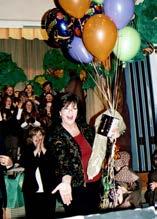
Voters went to the polls on Feb. 5, 2008, and approved repairing and updating Naperville 203 facilities. In a slim winning vote, homeowners approved the renovation and expansion plan for Naperville Central High School, the repair of the Naperville North pool, additions to Mill Street Elementary School, a new centralized early childhood center, and addressed security and safety concerns at a handful of schools across the District.
Naperville 203 asked voters to approve the issuance of $43 million in building bonds – the amount needed to cover construction costs above the $72 million the District anticipated would be available from other funding sources. In all, the projects were tagged at $115 million. The previous year, residents could tour the buildings, ask questions and offer feedback on various options as part of a community engagement process called “Touch the Future.” The extensive initiative involved community meetings in all 21 schools throughout August and September of 2007.
Ground breaks on Mill Street Elementary School. The addition would relieve overcrowding of the school.
Once the referendum was approved, concerns about the phasing and
planning began to ramp up. No one wanted the Central project to drag on beyond 2-3 years because they didn’t want a student living the majority of their high school years with construction.
Engineers and architects urged prudent planning and set major construction to begin in the summer of 2009 and to wrap up three years later. New spaces would be built first so that classes could be relocated to those spaces while renovation began on existing areas. Projects would be started and completed in phases so that work could be vacated at a certain point in time. Work would also be eased by the construction of a new three-story academic wing on the east end of the school.
Officials urged patience. “Not many people decide to spend three years renovating a building at the same time they’re running a school in the same building that they’re renovating as they move kids around,” said Superintendent Dr. Alan Leis at the time.
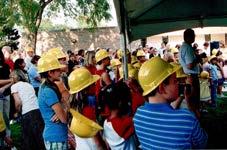
North’s new pool plan was for eight competition lanes, three shallow instructional lanes, three 1-meter diving boards and a handicappedaccessible pool lift. In addition, the pool locker rooms were to be renovated, parking was to be expanded, traffic areas reconfigured, and turf added to the stadium.
• School remained open on Election Day November 2008 despite many of the buildings serving as polling places. Naperville 203 administrators said they would work with the Naperville Police Department on security and traffic concerns; uniformed officers would have an increased presence and school staff would monitor people entering and exiting the building. No incidents were reported.
• Superintendent Dr. Alan Leis announced that he was retiring at the end of the 2008-09 school year. He was in his sixth year with the District and his 40th in education. He took over the position on July 1, 2003, from retiring superintendent Donald Weber. At the time, the Board of Education said it chose him because he was “an outstanding education professional” who also was a “great communicator.”
• The Board began its search to select Leis’ successor by holding 16 focus groups with stakeholder groups.
• Thanks to a collaborative partnership between the District and Anderson’s Bookshop, First Lady Laura Bush and her daughter Jenna Bush visited Naperville in April to read and discuss their latest book, “Read All About It!” The book is about a class clown who rules an elementary school and goes by the mantra “books are so last year.” In addition to Anderson’s Bookshop’s public event at the Naperville North auditorium, the first lady and her daughter met separately with some second-graders. Thanks to Anderson’s, students also got to interact with other famous authors, such as Presidential daughter Caroline Kennedy, actress Julie Andrews, singer Gloria Estefan, and baseball legend Cal Ripken, Jr.
• The Board of Education decided to save money and go paperless by adopting an online meeting manager, called BoardDocs. The online system allowed the District to update, distribute and archive board meeting agendas and minutes online, thus eliminating the large task of copying and distributing those items. The documents would be more readily available to the public. The District anticipated it would save significant labor and copying costs.

• Kennedy Junior High School was one of only five public middle schools in Illinois to earn the National Blue Ribbon Award of Excellence.
On July 1, Mark Mitrovich officially became Naperville 203’s new superintendent. The 30-year educator had founded EdGate, a K-12 data solutions company, before returning to the public sector. In selecting Mitrovich, Board Member Michael Jaensch said at the time, “He’s a true visionary thinker and a great educator, but, most importantly, he’s going to be a great fit for our community.”
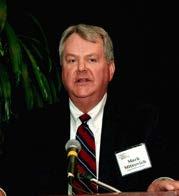
At long last construction began on Naperville Central. The phased-in approach kept work confined to the new wing at first, then moved to the flat wing, which was essentially rebuilt, and academic areas. The project created roughly 170,000 square feet of new space and 370,000 square feet of renovations. As always, there were snags and trade-offs during the project. While there would be a new playing surface at Naperville Central’s Memorial Stadium, the Redhawks had to play eight football games on the road in 2009. And a three-week strike by some workers’ unions not only delayed the Central project, but worried officials about pushing the start of school back.
Central students were excited about the transformation. “Naperville Central could not have been more different between my freshman and senior years,” said Madeleine Behr, who graduated in 2011. “My first year, my locker with my best friend, Hannah, was on the third floor. And too often during rainy days, there would be small garbage cans, usually used in classrooms, in the center of the hallways, gathering water drips from the ceiling. By my senior year, those classrooms got to keep their garbage
cans, and we gained nice views of the football field we could look out to during class.
“But it was dicey. The summer of my senior year the new building was close to opening, there were rumors that we’d have to go to Naperville North for the start of school because of the construction worker strike. Thankfully, that didn’t happen.”
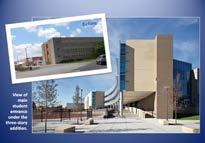
There were trade-offs for Naperville North, too. The $5.2 million of upgrades at North included expanded and reconfigured parking, which meant that the prairie gardens on the northeast corner would be bulldozed. But thanks to guidance counselor Marty Conner, the plants were rehomed to other wildflower sites and groups such as the DuPage Chapter of the Wild Ones and the Naperville post office.
Doors, speakers, a phone booth and other items were salvaged from Central and auctioned off to raise money for the Honor Garden. The garden, which is a way to honor graduates who have passed, would include seating, plantings and performance space. It was the idea of the Class of 2003, which lost five members. The garden is located in the front of the school.
When the construction was finished I remember thinking it looked like the set of ‘High School Musical,’ that’s how impressive it was!
SARA KINNEY, CLASS OF 2011
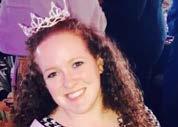
Shannon Maher was diagnosed with cerebral palsy when she was 2 years old. Her family moved to Naperville when she was a child for the schools. The River Woods, Madison and Naperville Central graduate always wanted to be treated like any other student. But it was her teachers that helped her realize that she didn’t have to hide her disability to fit in.
In 8th grade she was terrified of public speaking and her English teacher, Dianne McGuire, gently prodded her to work through her fear and also to tell her story. She wrote a personal narrative about her disability and read it to her class. It was the first time she realized “why am I trying to hide who I am? There are people who are willing to accept me and befriend me for who I am.” That speech helped Shannon conquer her fear and realize how sharing her story could help both her and others.
She credits another teacher for helping her advocate for herself. Pat Adamatis coordinated the Adaptive PE program at NCHS, pairing students with disabilities with student mentors. “Mrs. Adamatis always had this positive can-do attitude and believed in my own abilities and helped me embrace my disability identity,” Shannon said. Adamatis didn’t say no when Shannon wanted to try the high ropes course and she helped Shannon obtain a Segway so that she could use it to maneuver the hallways at Central during passing periods. It was a game-changer in how others saw her. She was no longer the “wheelchair kid,” and now could look others in the eye. Shannon graduated from Naperville Central in 2009, was the school’s Homecoming Queen that year, and a year later was the 2010 queen of the Naperville St. Patrick’s Days parade. In 2016 she was named Ms. Illinois Wheelchair Queen and competed in 2017 for Ms. Wheelchair
America, which gave her a voice to advocate for others who were disabled. Shannon is now married and lives in Arkansas and works at Disability:In, managing their Next Gen program, connecting companies to young executives with disabilities.
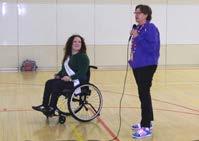
• When the Naperville Cemetery took back its land that had been leased to Naperville 203 for practice fields, Naperville Central needed more room for sports practices and P.E. After a year of collaboration, the park district, city, and school district created an option that they felt was a win-win for everyone. The plan called for creating multi-purpose athletic fields, parking, landscaping and trail areas in the southern portion of the West Street Garden Plots; relocating approximately 216 garden plots from the southern portion to the northern garden plots area and expanding garden plots to DuPage River Park.
• Napervile 203 picked up the tab for crossing guards after the City of Naperville said it could no longer fund the service. The District absorbed
the cost of 11 crossing guards to help shepherd students to and from school at major intersections throughout the city.
• Santa’s elves -- Naperville 203 staff and parent volunteers -- helped sort and pack gifts for 660 students in need in the District’s annual Holiday Gift Program. The yearly program, coordinated by the Naperville Education Foundation, has a slew of major contributors including local Rotary Clubs, the Park District, Edward Hospital and Secret Santas. As the needs of families have grown over the years, so too has the program. “We have had an incredible amount of support from all corners of the community,” said Maureen Dvorak, a D203 staff member who had coordinated the program.
My District 203 colleagues have been my parents, brothers and sisters, and now 34 years later, they are my sons and daughters. I have gone through marriages, divorces, having children, sending them to school, then college, plus the everyday struggles. They have been my support to become a better teacher, colleague and person. I owe so many people my appreciation and love!
TANA WILLIAMS, STEEPLE RUN ELEMENTARY STAFF MEMBER
District officials announced in December that during wintery weather, schools would start later rather than canceling school for a snow day. On mornings when a late start day is declared, school, in most cases, will start two hours later than normal. The late starts would be announced on the webpage, via email, phone, and text. A late start would preclude closing school for a full day.
• Naperville 203 reassured parents about H1N1 flu and the extra precautions they were taking following the death of a Naperville North freshman. They said they were experiencing more influenza-like illnesses at schools and urged parents to keep children at home if they were symptomatic. Absenteeism hovered around 3-5% in the schools, which they said was not “out of line” with the cold and flu season. The District encouraged hand-washing and custodians ramped up cleaning of hightouch areas in the schools. Just a few months earlier, in April 2009, the nation and our communities were closely monitoring swine flu. While Kane County schools were closed because of a larger uptick in swine flu cases, there was little effect in Naperville 203. A year later, several students were infected with MRSA and the schools notified parents to be extra vigilant of symptoms.
The new Ann Reid Early Childhood Center opened, the first green building in the District, and the first to be named after a District 203 teacher and a woman. The naming was significant as other elementaries were named after mayors, the streets they were on and Joe Naper, the founder of Naperville. Ann Reid was a long-time speech pathologist and an administrator in the District, and her name was chosen overwhelmingly by a committee of staff and parents. The opening of Ann Reid marked the first time that the entire preschool program was housed in one facility. Its funding, through the 2008 referendum, was a testament to the community which supported investing in the youngest and most vulnerable population of special education students. The 48,000-square-foot school sits on an 11-acre site at 1011 S. Naper Blvd., which used to be Huntington Estates Park. The cost to build the facility was $11 million. The school opened with 260 students but soon outgrew its capacity of
310 students, and preschool students were later housed in some other elementary schools.

As part of the work to relieve overcrowding at Mill Street and reduce class sizes, the Board of Education approved boundary changes for both Mill Street and Elmwood elementary schools beginning with the 2011-12 school year. Students in fourth and fifth grades and their younger siblings would have the option of remaining at the school. As a result, some Mill Street students would be reassigned to Elmwood, and up to 28 students could move from Elmwood. In many cases, students would go to school closer to their homes.
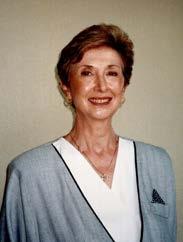
• Naperville Central and Naperville North were ranked by Newsweek as among “America’s Best High Schools” in its 2010 edition. A total of 1,600 schools were identified as the best by the magazine. The national ranking is based on a formula that divides the number of Advanced Placement and International Baccalaureate tests taken by students into the number of graduating seniors from approximately 27,000 of the nation’s public high schools. This measurement placed the schools in the top 6% of high schools in the country.
In a harbinger of what’s to come in the next decade, Naperville 203 launched a series of presentations on cyberbullying.
The Naperville Police Department and Naperville 203’s Technology Department teamed up to present information on internet predators and told parents “cyberbullying is not just something that happens outside of Naperville.” Naperville Detective Rich Wistocki, who is well known for his work on cyber crimes big and small, said no one online is anonymous and that parents are responsible for their child’s online life. Schools were under a new mandate to incorporate internet safety into the curriculum at least once a year for students in Grades 3 and above. School officials said they were developing an anonymous victim form for bullying, would provide ongoing seminars for parents and would develop an anti-cyberbullying campaign in addition to adding policies to address the new curriculum.
• As temperatures hovered around the 100-degree mark in early September 2011, Naperville 203’s neighbor, Indian Prairie 204, canceled classes at many of its schools. But, all Naperville 203 schools had air conditioning and thankfully all systems were functioning. Years later, Indian Prairie District 204 retrofitted its schools with air conditioning. Realtors often said AC was a selling point for Naperville 203.
• Naperville 203 launched a Centralized Enrollment Office, making it a lot easier for parents to enroll their children in school.
Before, if a new family had three children all in different schools, they would have to visit all three schools to enroll each child. Now, they would visit the District office at 203 W. Hillside Rd. The office also employed a Spanish speaker.
• With gas prices surpassing the $4 mark, there’s pain at the pump for Naperville 203 that’s affected the bottom line. The fleet of 188 buses used daily will mean transportation costs will be way over budget. 2012
Assistant Superintendent Dan Bridges was named as Interim Superintendent following the resignation of Mark Mitrovich. After two months in the role, the Board of Education felt it had found its leader, took out the interim in his title, and offered him a three-year contract.
Bridges was hired in June 2011 as Assistant Superintendent for Secondary Education in Naperville 203. Board members said Bridges was committed to community engagement, transparent communications, and working with diverse populations; in addition to being a collaborative manager and ethical leader.
We knew we were looking for someone who is both an outstanding manager as well as a collaborative, yet inspirational leader.
After nearly a year of study, the Board of Education approved a scaleddown plan for boundary changes for the coming school year that balanced enrollment among the elementary schools and relieved crowding at Mill Street and Beebe.
Administrators said that leveling out enrollment now will pave the way for all-day kindergarten in the future. Educators said that Common Core Curriculum standards soon-to-be implemented demand more instruction time beginning in kindergarten. Naperville 203 offered a half-day kindergarten program, while at the time 85% of Illinois school districts offered a full-day program.

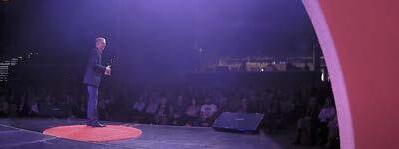
Lincoln Junior High sixth-grade teacher Josh Stumpenhorst was named Illinois Teacher of the Year in 2012. Only a nine-year teacher, he was selected for the honor among 200 nominations and nine finalists. When asked what the key to his teaching success was, he said: “Being a good listener. I approach the children as being a kid first, a student second. It’s all about the relationships you form.” Since then he has been enlisted to speak at numerous local, state, national and international conferences. In addition, he has given a TED talk, written two books and was honored with the Illinois Education Association’s Excellence in Teaching Award and named as a Pearson Foundation Global Learning Fellow. Stumpenhorst currently serves as the Learning Commons Director at Lincoln, where he taught for 13 years prior. He oversees the Library, Makerspace, video production lab and school arcade.
Recently, Stumpenhorst said the honor allowed him “to travel across the country and work with great educators while also being able to share the amazing work that happens in Naperville 203.”
Over the last 20 years, there were demographic changes in Naperville that saw an increase in students in the north end of the school district and a decrease in the south end. An Enrollment Capacity Study Group was formed to study how those changes affected the schools and to determine a variety of boundary scenarios.
• ”We extend our sympathy to the families and community in Newtown, Conn., for the tragic loss they are feeling and the fear that comes from such a senseless act,” the statement read on the Naperville 203 website. It was posted and sent to parents following the shooting of 28 people at Sandy Hook Elementary School. “Our thoughts and prayers go out to the teachers, staff and administrators of the school who place the safety of their students above their own needs. We know all too well the pain a school and a community feels when violence takes the lives of those we care about, especially children.” The District offered tips for speaking to children about traumatic events and noted that its schools practice lockdown drills and response plans in case of an emergency. It was the beginning of a series of letters that would go out to parents about shootings at schools. And, it would spark conversations across the country about increasing school security.
• Naperville 203 officials celebrated the results of the Illinois State Report Card, which showed that schools made Annual Yearly Progress (AYP) on 90% of indicators. The District achieved the distinction on 334 out of 363 indicators compared to last year, when they made 332 out of 363. A total of 11 of 14 elementary schools achieved AYP in reading and math, and most junior highs made AYP except for one subgroup. Naperville Central and North High Schools also achieved AYP except for some subgroups in reading and math.
• Naperville 203 educators were among 10 honored for their exemplary work in education. Kathy Burns, a second-grade teacher from Highlands Elementary School, and Pam Kelly, a first-grade teacher from Naper Elementary School, were honored by the Golden Apple Foundation and were chosen among 600 nominees.
The Board of Education looks to the future with an ambitious community engagement process. Called Future Focus, the District held a series of forums throughout the year attended by some 450 community members. Out of those meetings came 27 recommendations. A sampling of those were: Measuring student success beyond test scores or report cards; Assessing post-secondary success; Developing a social/emotional learning plan; Exploring online and blended learning options; and Reviewing the school day to optimize student learning and professional collaboration. In short, the feedback honed in on four areas: student success, programs of study, finances and facilities.
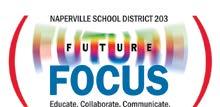
When presented to the Board of Education, Board of Education President Jackie Romberg praised the work. “This is a living, breathing document. It will not be put in a drawer or computer and be filed away,” she said.
Future Focus Committee: Chairs Mark Trembacki and Kathy Ruiz; members Bill Anderson, Tom Carroll, Mike Crossett, Loren Francis, Peggy Franks and Alissa Johnson-Tripas; staff representatives Dan Iverson and Gretchen Zelinski; district leaders Dan Bridges, Julie Carlsen, Jennifer Hester and Susan Rice; Board of Education members Mike Jaensch and Suzyn Price; administrative support personnel Ann Bell, Maureen Dvorak, Betty Stevenson and Deanne Fulner; and Unicom Arc consultants Dan Burns and Rod Wright.
In November, the Board of Education approved offering full-day kindergarten at all of its elementary schools, beginning with the 2013-14 school year. All-day kindergarten was already piloted at seven schools,
which were selected because they receive federal Title I funds to assist in early intervention activities.
Naperville 203 had been studying and laying the groundwork for the extended kindergarten program for more than a year. Officials said that Common Core standards were adding more rigor and that an all-day program was a solution.
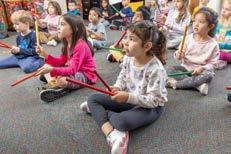
They cautioned that, in addition to more in-depth work in early literacy and math, there would still be choice time and time for play.
The move to an all-day program aligns with many other school systems in the area. Start-up costs were $1.2 million for this pilot year, $1.3 for the coming year, and $2 million to operate annually.
• A virtual charter school was being proposed as an alternative for about 500 at-risk students in the Fox River Valley area, but there were 18 public districts in that area that were to help fund it, including Naperville 203. Each voted down that prospect. The state mandates that charters receive 75 to 125% of what a school normally would have spent per student. Board of Education members from the 18 districts said that their schools already provided the services offered by Virtual Learning Solutions. While the legal wrangling continued for months, eventually the charter school director resigned and the school never materialized.
• Following a change in law passed the previous year that reaffirmed Edward Hospital’s non-profit status, Naperville 203 was required
to refund the hospital $2.2 million in property taxes. The General Assembly had allowed non-profit hospitals to be exempt from local property taxes if they can show that they have done charitable work equal to or more than the property taxes they would otherwise owe, and allowed hospitals to claim property tax refunds for the three years before the law’s passage.
• It’s not often that schools close for rain, but the six to eight inches of rain that fell April 17-18 prompted the closing of school in Indian Prairie District 204 and made attendance optional for students in Naperville 203. The rain flooded streets, businesses, and basements and caused the DuPage River to leap over its banks.
I have been an active member of the District 203 community for 50-plus years starting as a student, then teacher, and also parent to my three sons (my family of five are all NCHS graduates)! All of the experiences have influenced my life in a positive way making it my very special home district.
JULIE GROVES RANCH VIEW ELEMENTARY STAFF MEMBER• With teen drug use rising across the country, schools were under pressure to test students for drugs. Naperville 203 studied the issue, but decided against mandatory drug testing for students in co-curricular activities, unlike some neighboring districts.
Rigor was the defining word of the year. After revising its math curriculum last year, Naperville 203 launched a new language arts curriculum and is working on a new science curriculum. All are in response to aligning to the new, more rigorous state standards and Common Core curriculum.
The new science curriculum is to encourage more students to pursue careers in science, technology, engineering, and mathematics (STEM). The goal is to have students learn more about science and start
thinking like scientists. Students will be learning the concepts through practicing science, which is a fundamental shift away from memorizing facts.
With a more exacting curriculum came a more rigorous assessment. Results on the 2013-14 Illinois Report Card showed Naperville 203 continued to far exceed state averages in reading, math and science. This was the second year that the assessment reflected the more stringent curriculum. The District was especially proud of closing the gap in achievement within subgroups of students, a push by the state in recent years. Especially noteworthy were math gains among Hispanic students and low-income students, a result, officials said, of the more stringent math curriculum.
“We have more work to do,”
Superintendent Dan Bridges said at the time. “A celebration is we have made progress in closing achievement gaps in several areas.”
In a move that was denounced by some parents, Naperville 203 eliminated what they termed an old model of instruction and moved to a new model of supporting students in the classroom. In the old model, students were pulled out of the classroom for reading support or other support. The new model, which will be put into effect in the 2014-15 school year, will put those teaching assistants into the classroom to work with all students. The District later hired back many of those for 48 new instructional assistant positions, who support all students in the classroom. School officials said the District is not abandoning early reading intervention but rather supporting and preparing all students for a rigorous curriculum.
Naper School’s 4th grade and the woodshop team at NNHS collaborate on a STEAM project.

Since the school shooting at Sandy Hook two years ago, keeping students safe and the building locked down has been an overriding concern across the country. It was no different in Naperville. A new state law now required schools to conduct active shooter drills.
Schools began the drills and wanted to strike a balance between keeping students safe and not alarming them unnecessarily, a concern that would build in years to come.
As technology made more things possible, online was a new way to learn in Naperville 203. In 2014, there were nine courses offered online in partnership with Indian Prairie District 204 and Community Unit School District 200 (Wheaton Warrenville): American government, English 9/10, English 11/12, Consumer Education, Mandarin Chinese, Geometry, Health, U.S. History, and Web Design. Consumer Ed and Health were the most popular classes. The consortium planned to add more classes next year and offer its most popular classes in the summer, which would benefit students who don’t want to be or have time to be in a physical classroom.
The partnership was developed the prior year and called Expanded Learning Opportunities or eLo Consortium. In the three districts, 205 students took advantage of the classes’ reading assistants and enrichment assistants.
• A lightning strike and storms postponed the Naperville Central and North Class of 2014 graduations for one day. Just as the members of the class were filing into the outdoor stadiums, the storm erupted, prompting officials to cancel the event and reschedule it for the next evening. It is a tradition cherished by students that the commencements are held outdoors, one that allows the entire class to celebrate together.
• The unrelenting, bitter winter of 2013-14 was one of the coldest in the history of the Chicago region. It was also one of the snowiest Januarys on record. The arctic air prompted the cancellation of school on Jan. 27 and 28.
For 24 years, Russ Marineau volunteered with and/or chaired HURRAH (Happy Upbeat Retirees (and other) Residents Actively Helping) Executive Council, the group that recruited and placed senior citizens in the schools as volunteers. He helped grow the Naperville 203 community
relations organization into a robust band of volunteers who were valued in the schools. Principals determined HURRAH’s focus in their schools: mentoring a troubled student, working with a student on study skills, serving as a classroom helper, assisting with clerical duties in the office, or tutoring students.
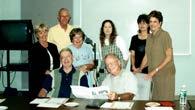
He liked to say that retirees get as much, if not more, out of assisting students. Before he began volunteering at Washington Junior High in 1991, Marineau retired from a 30-year career at IBM. In a twist to the program in 2013-14, high school students interested in wellness partnered with Benedictine University to develop a fitness program specifically tailored for senior citizens. HURRAH seniors received fitness and strength assessments and instruction on how to use exercise equipment. Marineau died on July 24, 2015 at the age of 81.
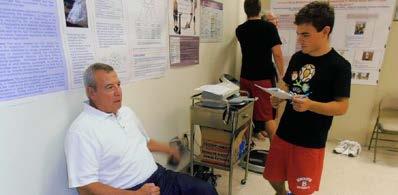 Russ Marineau, pictured with newspaper, was the long-time chair of HURRAH, the retiree group who volunteered in the schools.
Russ Marineau, pictured with newspaper, was the long-time chair of HURRAH, the retiree group who volunteered in the schools.
Facility improvements, security, and technology continue to be on the docket of Board of Education agendas throughout the year, as well as changing demographics and declining enrollment.
Five more elementary schools underwent a renovation of their front entrances, adding vestibules, call buttons, and driver’s license scanners, which overall increased security for the schools. Other work was to upgrade science lab stations at the junior high schools by 2017-18 to help them comply with new federal science standards. Naperville 203 also developed a plan to revamp the science curriculum in Grades 6-12 that encouraged freshmen to take Chemistry, followed by Biology in Grade 10 and Physics in Grade 11. The change was developed to meet the mandated Next Generation Science Standards.
Enrollment continued to decline, and near the end of the year, Naperville 203 cut about 16 teaching positions across the District. A study showed that enrollment had fallen to 16,438 students this school year, a decrease of 910 from 17,348 in 2011-12. The demographer said that trend should continue and the District should expect a drop of 1,125 students by 2019. He noted that Naperville was “aging” and those demographics were also changing, as 13.4% of students were from low-income homes.
Projections showed that Naperville 203 would need fewer teachers at the elementary and junior high levels for the 2016-17 year.
Technology in the classroom took a big leap. Ten years after this photo was taken in 2007, 8,000 Chromebooks were provided to all high school students. The next year, 6,000 were distributed to junior high students.

Eight thousand Chromebooks were handed off to students at high school registration before the start of school. It was a Herculean effort to prepare and configure the laptops and plan and prep for the digital initiative. Phase I of the plan to ensure that every student in the district had a district-issued device to use in class and at home went off without a hitch. The significance of the initiative was immense: a more equitable environment for students and efficiencies for teachers and better engagement and participation for students. The next year, 6,000 Chromebooks were distributed to junior high students, and the following year Chromeworks and iPad devices would be provided to elementary students depending on their grade level. The student technology fee would cover the costs for the school districts to lease the devices.
Officials celebrated the results of the PARCC (Partnership for Assessment of Readiness for College and Careers) exam, which reflect the new Common Core standards. Overall, Naperville 203 students, not surprisingly, performed at a much higher level than those statewide. In English, 68% met or exceeded expectations; and likewise, 60% in math. Statewide, averages dropped considerably. The PARCC test was given to all Illinois students in the spring of 2015 and replaced the Prairie State Achievement Exams (PSAE) for high schoolers and the Illinois Standards Achievement Tests (ISAT) for elementary students. It was criticized widely in the state for its length and perceived difficulty.
• Meadow Glens was one of 335 National Blue Ribbon Schools honored by the U.S. Department of Education. It was recognized in the category of Exemplary High Performing Schools and celebrated at a ceremony on Nov. 9-10 in Washington, D.C.
• Six hundred people attended Naperville 203’s inaugural picnic for new and existing families. The free event showcased all of the many resources and community organizations available for students’ families.
• Newsweek Magazine ranked District 203’s high schools among the top 100 in the country. Naperville North ranked 58 and Naperville Central ranked 95. “Any time our schools are recognized for their great work, it reflects the exemplary partnership among our students, staff, parents, and community,” Superintendent Dan Bridges said at the time. Similarly, the U.S. World Report’s 2015 Best High Schools ranked North and Central as among the best in the state. They also ranked the schools using a college readiness score that analyzed the number of Advanced Placement tests students took and passed. Naperville Central’s 42.8 college readiness figure is figured on 48% of students completing an AP test with 41% passing. Naperville North had a readiness rating of 40.6 with 44% of students taking an AP test and 39% passing it.
• Naperville 203 sold 1.75 acres surrounding Hobson Nursery School to the Forest Preserve of DuPage County for $630,000. The land was added to the 14-acre Goodrich Woods, which is owned by the Forest Preserve in partnership with the Naperville Park District.
• Six juniors from Naperville Central and four from Naperville North earned perfect scores on the February or March ACTs. According to ACT, less than one-tenth of 1% of students who take the college-readiness exam log a perfect score.
In 2015, Naperville 203 students conducted their last science experiments on the “Late Show with David
Letterman,” coinciding with Letterman’s retirement. It was the 24th time in 18 years they performed wacky experiments before the audience. Naperville North Science Teacher Lee Marek conducted solo experiments on the show in the early 1990s, but show producers asked if he could round up a few students to perform the experiments. Every year since then he and other teachers accompanied students to New York City to appear on the show.
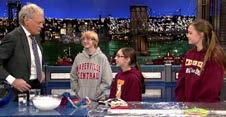
Fifth-grade classes at Naper Elementary moved to Washington Junior High this year to ease overcrowding at what is one of Naperville 203’s smallest schools. School officials said they are accustomed to helping students transition to junior high and will adapt that model to fourth graders. Naper’s population hovered around 295 last year and its size means that art and gifted education are conducted in the resource center. Moving fifth grade allowed for two classrooms of all-day kindergarten at the school and greater flexibility as needed each year, such as an additional classroom section or a dedicated classroom for art.
At Washington, to avoid mingling with the older students, fifth-grade classrooms, bathrooms, and lockers were clustered together and monitored by teachers. The elementary arrival and dismissal schedule also remained the same.
Later in the fall, an enrollment report showed that steady enrollment declines could be slowing soon. District officials said declines were smaller than projected and they had seen an increase in the number of elementary children moving into the district. There is also a rising birth rate, and while projections can easily be made using birth rate models, it is more difficult to project how many families will move into the district.
It was the first year that every junior high student received a Chromebook to take home and use in school. Parents were urged to focus on what is good and bad digital behavior, and how to have a conversation to monitor students’ activities.
Before receiving a Chromebook, students and their parents were shown a video on digital citizenship and how to be responsible with the devices. The previous year, the program, called the 1:1 Initiative, was launched for high schoolers.
In addition, Devorah Heitner, author of “Connecting Wisely in the Digital Age,” talked to parents at a Focus 203 about raising children in a digital age. She came to Naperville as part of the District’s digital learning initiative.
Kennedy Junior High maintained its status as a Blue Ribbon School by earning the honor for the third time in 2016. KJHS also received the designation in 2002 and 2008 (pictured here).
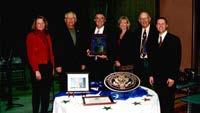
• Lacrosse became an official sport in 2016-17. The Board agreed in October 2014 to begin transitioning the sport into an official sport for both boys and girls and provided some funding for uniforms last year. IHSA, the state athletic governing body, has declared the sport as “emerging” though athletes must abide by IHSA rules.
• Kennedy Junior High School was again selected as a 2016 National Blue Ribbon School, the third time it was named for the national honor.
• Naperville 203 officials continued to work hard at reducing achievement gaps in underperforming groups of students. For the last four years the District had studied culturally responsive practices to address these achievement gaps within the student population. They were working on targeting students earlier and providing them with better access to testing opportunities.
• All-day kindergarten was deemed a great success after math scores from first grade showed impressive jumps. The increase in math scores recorded by students in the first grade after they had completed all-day kindergarten showed a 10% growth from 2013-14 to 2015-16. Reading scores showed a 15-point increase during the same period. Additionally, a May 2015 parent survey showed 95% were satisfied with the full-day model and 95% indicated the program was developmentally appropriate for their student.
• Naperville was named one of the top safest cities in America to raise children and the only one in Illinois mentioned. The home security rankings website Safewise ranked Naperville No. 19 for its kid-friendly programs and low crime rates. In determining the ranking, Safewise
analyzed FBI crime data, sex offender data, student graduation rates, school rankings, and school district programs. Specifically, Naperville 203 was noted for its digital learning initiative.
• In the face of a state budget impasse and continued threatened reductions in state funds, Naperville 203 was able to trim its 2016-17 budget by nearly $800,000. Each year, 90% of the budget comes from property taxes and other local sources.
• Administrators said in June that while they will be able to open schools as planned, they will start to identify areas to cut if the state budget impasse does happen.
• Adarsh Mattu and Prateek Dullur, of Naperville Central, and Aditya Ramachandran, of Naperville North, met President Barack Obama and were honored guests at the 2016 White House Science Fair. They had won a national science competition a year earlier, earning an invitation to the White House.
If you see teens huddled and with their heads down, it might be the latest craze hitting Naperville. Naperville 203 was swift to block access to the game “Pokémon Go,” a digital game where players can collect Pokéballs around town to catch Pokémon creatures, District 204 did the same. Edward Hospital requested that it be removed as a Pokemon Go location; its circle drive was known as a Pokemon gym where players can train their creatures to battle other players.
Locally, physical therapists sounded the alarm about “text neck” and said they had never seen more neck and back pain and injuries. They ascertained it was due to folding chins to the chest for texting.
Citing substantial progress in Naperville 203, the Board of Education extended Superintendent Dan Bridges’ contract for five years until 2023. The School Board cited students’ academic achievement, the implementation of all-day kindergarten, the 1:1 initiative that put a computer into the hands of students, late start day for high school students, and more time for teacher training.
Three accolades stood out in the year 2017. Student ACT scores took a substantial jump. The Class of 2017 composite score was 25 compared to the previous year’s post of 24.8.
Niche.com ranked Naperville 203 as the No. 3 top school system in the state behind New Trier (No. 1) and Libertyville/Vernon Hills (No. 2). The ranking was based on Niche.com’s proprietary data and U.S. Department of Education data, as well as survey responses. The analysis includes state test scores, college readiness, graduation rates, SAT/ACT scores, teacher quality, and public school ratings.
The third accolade was that Naperville Central and North students could now apply for an Illinois Seal of Biliteracy or state commendation toward biliteracy. The remarkable achievement would now be recognized on a student’s diploma and transcripts. The seal is awarded to graduating high school students who demonstrate a high level of fluency in reading, writing, listening, and speaking in a foreign language. A commendation is given to students who can effectively communicate in multiple languages.
With the state budget woes behind them, Naperville 203 planned to add staff in the 2017-18 school year to close achievement gaps. In the last three years, the District had worked hard to close the achievement gap among smaller subgroups of students including Hispanic, low-income, Black, English learners and students with disabilities. The District would add 19 full-time educators, including
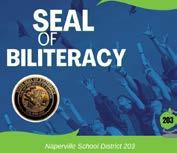
instructional coaches, math specialists and others for $1.8 million. There was also a need for 12 full-time special education and English language educators for $1.05 million annually.
• Naperville North and Central High School students scored an extra hour of sleep every Wednesday morning in the 2017-18 school year. The late start allows teachers to have time to meet and plan. Classes started at 9:00 a.m., rather than the regular time of 7:45 a.m., but still finished at the usual time of 3:10 p.m.
• The mental health of teens became a bigger concern this year when there were three teen suicides in the Naperville community early in the year. Naperville 203 held a special community engagement Focus 203 session on the topic and the city and mental health experts created a Naperville Mental Health Steering Committee to study the problem and recommend solutions. In addition, Naperville 203 provided two community forums on suicide. Adding to the controversy was a popular Netflix series called “13 Reasons Why,” a show based on a book by Jay Asher about a high school student who commits suicide and leaves behind audio recordings documenting the 13 reasons why she chose to end her life. Naperville 203 officials issued a warning to parents urging them to have a conversation with their children if they have watched, or would like to watch, the series.
Naperville 203 implemented the next phase of its digital learning initiative when it rolled out Chromebooks for every third- to fifth-grader and iPads for every second-grader. Students in kindergarten and first grade shared iPads 2:1. Technology fees for elementary students increased from $29 to $50 to pay for the lease.
The District launched its Social and Emotional Learning (SEL) curriculum in all of its schools, one of the first school districts to do so. Illinois was a leader in developing SEL standards, which teach students how to identify
emotions, control them, empathize, work with others, and make responsible decisions. Officials said incorporating SEL into the daily curriculum would increase academic achievement, help provide a positive school climate, improve student attendance, and allow students to better use coping skills.
(Naperville Central) was special first and foremost because of the teachers and other staff. There was also a culture of acceptance and inclusivity that I’ve yet to see elsewhere and is why I’ve now moved back to this school district to have my own children grow up in that special environment.
“”With school security a rising concern throughout the country, schools were hiring chiefs of security. In Naperville 203, Louis Cammiso, a retired police officer, was appointed to fill the newly created position of Director of Safety and Security. His role was to develop and implement security procedures and provide training to staff. The District also transitioned to the new safety training program known as ALICE (Alert, Lockdown, Inform, Counter, Evacuate). While there had been a call from rural downstate districts to arm teachers with guns to thwart potential school shooters, Naperville 203 opposed such legislation. Board of Education members said no evidence suggested that arming teachers and staff was a viable solution against an act of an active shooter, and said gun training should be left in the hands of professionals.
Just months earlier, Naperville North and Central students joined teens from across the country in school walkouts and protests to pressure Congress to enact stricter gun control measures. The events were in response to the school shooting of 17 people at Marjory Stoneman Douglas High School in Parkland, Fla.
• Naperville North High School was named a National Blue Ribbon School, one of 349 schools in the U.S. chosen in 2018. The recognition is based on a school’s overall academic performance. Only 24 schools in Illinois earned the distinction in 2018.
• With concussions a concern and its interscholastic football program participation declining, middle schools decided to replace tackle football with flag football. It used to be that there were enough students for three weight classifications; now there are only enough for two.
• Again this year, the Board of Education voted that homeowners will get a break on their property tax bills. This combined with its vote earlier in December to abate its 2016 debt service levy, the owner of a $410,000 home would pay roughly $107 less than it otherwise would have paid. Annually the Board of Education determines whether to abate all or part of the debt service levy from its 2008 referendum. For both 2016 and 2017, it determined that it has adequate resources to make the required bond payments.
• A record 29 Naperville 203 students earned a perfect 36 on the ACT, a rare feat that is achieved by only one-tenth of 1% of all test takers. They included NNHS seniors Richard Cao, Howie Guo, Kathryn Jin, Lauren Sun, Jonathan Vanderwater, Matthew Vaughn, and Felix Zheng and NNHS juniors Karen Ge, Benjamin Kan, Justin Griffith, Alec Manzardo, and Cindy Xue; and NCHS seniors John Biziorek, Rishi Ghorad, Mahika Gopalka, Brendan Gurnik, Phoebe Harmon, Mia Kurkechian, Yangyang Li, Ryan Park, Sanjana Ramrajvel, Elizabeth Reimer, Samuel Welch, Shirley Wu and Jamie Zhang and juniors Arjun Kumar, Ganesan Narayanan, Jack Reicherts and Alex Trickey.
With a national movement to strengthen and advance diversity, equity and inclusion, Naperville 203 created a new administrative position -- Executive Director of Diversity and Inclusion -- and Dr. Rakeda Leaks was appointed to lead the initiative.
A pilot breakfast program started at two elementary and two middle schools was hailed as a success and will be extended to all schools in the coming year. Surveys showed that students participating in the program who previously did not eat breakfast were better prepared to learn and had fewer discipline issues.
Among students that participated in the program, 71% qualified for free or reduced meals. School officials said that one in six students qualified for the free or reduced program based on federal guidelines. The program was launched at Mill Street Elementary, Scott Elementary, Jefferson Junior High and Madison Junior High. The cost of a meal was $1.50 at the junior high and $1.40 at the elementary school, but costs were waived or reduced depending on a family’s income level.
• Naperville 203 came to a compromise regarding the start of school in August and gave students four more days of summer. In previous years, the Board of Education had approved an earlier start date, which the calendar committee had also recommended for this year. But parents said an August 15 first day of school was a bit too early. So moving forward, the first day of school will begin four days later. Final exams in high school will continue before winter break.
• Kingsley Elementary School was one of 362 schools recognized as a National Blue Ribbon School. It was chosen based on its progress in closing achievement gaps among student subgroups, specifically a gender gap in the number of female students qualifying for mathematics programs, compared to their male peers.
Superintendent Dan Bridges’ decision to cancel school four days this school year due to weather earned him hero status in
students’ eyes. NCHS student Richie Holmberg used that status to put Bridges’ photo on a T-shirt and sell them. Bridges, who has a strong following on Twitter and often tweets back to students, was asked about using his picture on a T-shirt. He responded to Holmberg: “Let’s talk on Friday - if it goes to support @NEF203, I think we can do this.”
Superintendent Dan Bridges earned hero status for canceling school and a creative student decided to use that opportunity to make some money for a favorite charity.
The T-shirts raised $2,700 in four days. The money was donated to the Naperville Education Foundation.

• Naperville 203 spent an average of $16,000 per student, according to data included in the Illinois Report Card. It is the first year that the Report Card also included how spending varies within districts from school to school.
• The District and the Naperville Park District approved sharing the cost of installing a $4.25 million turf athletic field in Knoch Park. Naperville 203 would pay 43% of the cost and the park district would pay 57%. The new field would be used for team practices and competitions.
• Besides the field, other improvements were planned such as spectator seating, lighting, a press box and scoreboard booth, trails and pathways, landscaping, and park and field signs. The public would also get four lighted pickleball courts, funded by the park district. The improvements and a new softball field meant this was the last year for Ribfest, the popular Fourth of July celebration, at the park organized by the Exchange Club.
• Work was underway on a data dashboard to give the public a means to track progress on how effectively Naperville 203 is meeting its goals. The dashboard would be housed on the District’s website and track finances, academic progress and other benchmarks.
• Naperville 203, Indian Prairie School District 204, and Community Unit School District 200 dissolved the Expanding Learning Opportunities Consortium, effective June 30, 2020. eLo was formed as a way to counter a charter school offering online coursework. It would have pulled both enrollment and funding from the districts.
• For the first time, Naperville 203 sent parent communication out in a third language – Mandarin, to support that growing population. The email messages, called Talk203, were often translated into Spanish.
• A new Naperville chapter of March for Our Lives was organized by eighth-graders Peyton Arens, Lily Longenbaugh, Lucy Gosselin and Nathan May. The national March for Our Lives movement was started by survivors of the Parkland, Fla., high school shooting in 2018.
In early January 2020, the second case of COVID-19 in the United States was discovered in Chicago when a woman returned from the pandemic’s place of origin in Wuhan, China. Throughout the early part of the year, Coronavirus dominated the national news with the World Health Organization (WHO) officially declaring COVID-19 a pandemic on March 11.
As the U.S. watched cases spread rapidly in Europe, schools here remained open, but visitors to the buildings were canceled, field trips were put on hold, and spectators were barred from sports competitions. In early March, school officials quickly refuted a hoax on the social media platform Snapchat that said schools would be closed. But it was an omen of things to come. A few days later, on March 17, Illinois Gov. J.B. Pritzker ordered all schools and colleges closed, as well as restaurants and bars. For many, it seemed this was temporary, but the order was extended until April 30, and then again until May 29. In April 2020, the U.S. recorded 18,600 confirmed deaths and more than 500,000 confirmed cases in under four months, becoming the world’s global hotspot.
Throughout the spring of 2020, Naperville 203 schools were closed and classes took place online in families’ homes. The District rolled out its
e-Learning program to 16,500 students from preschool through high school. It was a significant time of stress for educators who had to learn new technology, quickly ramp up classroom management skills in a virtual environment, and deliver lessons for all digitally. But e-Learning wasn’t the only struggle. The pandemic upended lives. In some industries workers were losing their jobs and income, and parents as well as teachers had to juggle e-Learning for their young children along with jobs. End-of-year traditional events were canceled. Junior high ceremonies were held online and high school graduations were postponed until July. Fortunately, Naperville 203 was able
The school community went out of its way to thank teachers and staff during the long, trying days of the pandemic.

Schools were short staffed during the pandemic, leading Superintendent Dan Bridges and other administrators to substitute.
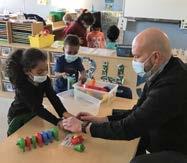
to offer five days worth of free graband-go meals twice a week to any student who wanted them, thanks to the federal school lunch program. They extended the service for the bulk of the summer. To help families in immediate need, the Naperville Education Foundation established a new fund to aid students and families with transportation, weekend meals, and other needs.
The summer was a difficult one, as schools were busy making plans to reopen with expansive health and safety plans in place, as well as contingency plans in case schools did not open.
In June there was additional strife in the community. High school seniors organized a Black Lives Matter protest in the city, which drew more than 300 people downtown to hear speeches. But the peaceful rally turned ugly when outside agitators joined the group. At around 9:30 p.m. police asked people to disperse and a short time later, several loud bangs were heard and people scattered. Windows had been broken on a number of businesses, planters and garbage cans were overturned and fireworks set off. It was one of many protests erupting throughout the Chicago area in response to the death of George Floyd, a Minnesota man who was killed while he was being arrested the week prior.
Parents and educators were weighing in at Board of Education meetings about fears of reopening and their opinions for and against wearing masks. But as cases ramped up and guidance from state and national health departments issued conflicting guidance, Naperville 203 delayed reopening schools in August 2020, like most in the county, until safety measures had been definitively decided.
Noting that it wasn’t ideal, Naperville 203 officials started school with e-Learning on Sept. 1, due to the high rate of COVID-19 transmission in the area and evolving state guidelines. The District had planned to offer inperson learning on alternating days and full online academies, but increasing COVID-19 cases and changing state guidelines had nixed those plans.
The delay was met with mixed results. Some parents formed alliances with IPSD 204 parents and held a rally in downtown Naperville urging officials to open up schools. Other parents were pleased with the slower transition. Superintendent Dan Bridges said that the re-opening had to be done thoughtfully and in full adherence to the new public health protocols.
He outlined a detailed “Return to Learn” plan in which students will return to in-person learning in phases, beginning with the youngest students. Yet, with cases rising even higher in the fall, moving from “moderate” to “substantial,” and the county health department urging that schools operate with 100% online learning, in-person learning was delayed again. The state’s term was called an “Adaptive Pause,” meaning that officials were monitoring COVID-19 conditions. Only specialized programs would continue.
• In June 2020, the Board of Education adopted a Comprehensive Equity Plan. The Board of Education and administrators pledged to commit to undoing inequities that may exist in policies and procedures, and to truly create an equitable learning environment for all students.
COVID-19 continued to dominate the news of 2021 and also the time and energy of educators, staff, administrators, and the Board of Education in Naperville 203. It was a daunting time. Health officials feared that the holiday gatherings, loosening of indoor dining restrictions and the resumption of youth sports would exacerbate the spread of COVID-19. In January, Illinois surpassed 19,000 confirmed COVID-19 deaths.
Yet, there was positive news. In January, Naperville 203 announced hybrid learning would begin, meaning students went to school for half days and had remote learning days the other half. The model satisfied state health guidelines for capacity and six feet of distancing, a challenge in all of the schools.
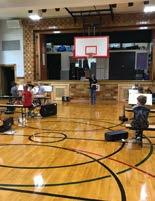
Vaccinations had rolled out in the state, first to healthcare workers and those in long-term care facilities. Soon, the vaccines would be offered to educators, then to the general public. The Naperville area had one of the highest vaccination rates in the state, in part due to the vaccination clinics offered in partnership between Districts 203 and 204. Naperville 203 was also one of the first to launch SHIELD testing and a “Test-to-Stay” COVID-19 program. This greatly reduced the number of students who had to quarantine at home.
After spring break, Naperville 203 resumed in-person instruction five days a week. Earlier, the state had eased its guidance for social distancing from six feet to three feet, and reduced capacity limits, which allowed the schools to launch in-person instruction full-time. Yet, social distancing at lunch remained a problem at the high schools. Schedules were set up so students would attend until 1:30 p.m. And, in May, the COVID-19 vaccine was authorized for use for 12- to15-year-olds.
Every facet of operations in the schools was affected by the pandemic. Already experiencing a teacher shortage, Naperville 203 worked hard to attract more substitute teachers, which were sorely needed in the last two years. As a result, the Board of Education approved increasing the daily pay and added a $100 bonus for every ten days days substitute teachers worked.
Teachers had to be creative in reimagining events. Here, Ellsworth band members put on a socially distanced concert to say goodbye to retiring teachers.
• To combat learning loss due to the pandemic, Naperville 203 also offered a free summer school class to all Naperville 203 students. The District created an extensive plan to help students bounce back from learning loss and mental health lapses from the pandemic. The District planned summer academic boot camps, hired extra teaching specialists for the fall, implemented tutoring services, and offered additional social emotional support. Many of the programs were funded through a $6 million federal ESSER (Elementary and Secondary School Emergency Relief) grant.
• To prioritize wellness and self-care during one of the most challenging years in education, Naperville 203 launched a program called “Optimistic School Community.” As families and staff transitioned from e-Learning to hybrid learning, the goal was to have families focus on what they learned and how they grew during the pandemic. Students and families were encouraged to participate in six interactive modules containing short videos, activities, and resources.
• The Illinois High School Association made plans to add esports, also called competitive gaming. The esports movement gained traction several years ago when more than 170 universities added varsity programs.
• In a partnership with the Naperville Park District, a new girls varsity soft ball field, athletic turf field and other amenities were completed at Naperville’s Knoch Park. The upgrades met a large need for athletic fields in the area, as well as expanded the park’s use by school athletes.
Three Naperville 203 elementary schools landed on the prestigious list of National Blue Ribbon Schools: Elmwood, Highlands and Steeple Run. All three schools were recognized as Exemplary High-Performing Schools, ranking among the state’s highest performing schools as measured by state assessments or nationally normed tests.
The pandemic continued to affect schools in many ways throughout 2022. Face masks continued to be a hot topic and were required by state law at the start of the 2021-22 school year. In February 2022, however, the courts ruled that the mask mandate had expired so school districts individually could decide how to address indoor masking. Naperville 203, like most in the region, shifted to making masks “strongly recommended” for students and staff and schools. Laws required masking to remain for students on school buses. Naperville 203 officials said they made the change to “recommended” following a decline in COVID infections.
Supply chain issues and staff shortages also plagued schools. Less than a month before classes began in August 2022, the District was still scrambling to secure cars for driver’s education students. Shortages for substitutes, bus drivers, teacher assistants and others were problematic.
Facing these shortages, the Board approved contracts with both its transportation union and maintenance custodial union, giving them a $1,000 one-time payment and bumping up starting salaries in order to attract workers.
Finally, there continued to be concerns about the mental health of students, which was common across the country. To support students and families, administration added two fulltime directors of outreach and student belonging – one at each high school. The directors serve as student and family advocates.
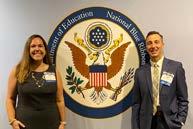
Yet, despite the pandemic, school officials said that there has been a swift academic rebound from two years of learning loss. On the Illinois Assessment of Readiness (IAR) administered in third through eighth grades, 67% of Naperville 203 students met or exceeded grade-level standards for English language arts, and 60% met or exceeded
mathematics standards. That’s compared to 59% in English and 58% in math in the 2020-21 school year.
In the 2018-19 school year, before the pandemic hit, 68% of Naperville 203 students met or exceeded English standards while 70% did so in math.
• The Board of Education agreed to abate $2.7 million of the 2021 debt service tax levy, the sixth straight year it had done so. The $2.7 million abatement saved the average owner of a $410,000 home about $70 from the Naperville 203 portion of their property tax bill. In all, nearly $17 million of the debt service levy has been abated in the last six years.
• In spring, citing sparse enrollment, the Naperville 203 Board of Education voted to eliminate Latin 1 beginning with the 2022-23 school year. An audit showed dwindling enrollment numbers at both high schools. Latin would be phased out over the next few years. Students currently enrolled in Latin 1 would be able to finish the sequence through Latin 2, 3 and 4.
• Long-time assistant principal Jackie Thornton was appointed as principal of Naperville Central High School beginning with the 2022-23 school year, succeeding Bill Weisbrook. She was the school’s first female principal. Weisbrook was at Central for 26 years, 14 as principal.
• The dress code was changed in 2022 and universally adopted as a District, not determined by each school. The largest change was allowing a hat or head covering if it didn’t distract from school. Another change was that students could not wear anything with speech, language or images that create a “hostile or intimidating environment for others, including any protected class or marginalized group.” The code used the American Library Association’s definition of hate speech.
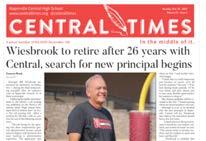 Long-time principal Bill Wiesbrook announces his retirement following the 2021-22 school year.
Long-time principal Bill Wiesbrook announces his retirement following the 2021-22 school year.
• At the end of the 2021-22 school year, the District held an inaugural event to show its appreciation to aspiring educators. About 30 high school seniors signed commitment certificates pledging to study education in college during Future Educator Signing Day. It was a day likened to Signing Day for high school athletes.
I had many teachers in my 12 years in District 203 that really made a difference to me. I am still in contact with several of them to this very day. I grew a lot and the relationships I formed during that time made me into the adult I am now, and that is something I will never forget (also worth noting, I met my wife at Naperville Central).
ELMWOOD 2022
HIGHLANDS 2010, 2022
KENNEDY 2002, 2008, 2016
KINGSLEY 2019
MEADOW GLENS
2015
NAPERVILLE NORTH
2018
STEEPLE RUN
2022

1011 S. NAPER BLVD., NAPERVILLE, IL 60540
Principal: Andrew McCree Enrollment: 349

110 E. 11TH AVE., NAPERVILLE, IL 60564
Principal: Christine O’Neill Enrollment: 590
1011 S. NAPER BLVD., NAPERVILLE, IL 60540
Principal: Kim Rutan
Enrollment: 236

1024 MAGNOLIA LANE, NAPERVILLE, IL 60540

Principal: Matt Langes
Enrollment: 670

525 S. BRAINARD ST., NAPERVILLE, IL 60540

Principal: Laura Noon
Enrollment: 494
2403 KINGSLEY DR., NAPERVILLE, IL 60565
Principal: Erin Marker
Enrollment: 436


1630 WARBLER DR., NAPERVILLE, IL 60565
Principal: Araceli Ordaz
Enrollment: 518
1150 MUIRHEAD AVE., NAPERVILLE, IL 60565
Principal: Katy Lynch
Enrollment: 480
1300 N. MILL ST., NAPERVILLE, IL 60563
Principal: Sue Salness
Enrollment: 586


39 S. EAGLE ST., NAPERVILLE, IL 60540
Principal: Tracy Dvorchak
Enrollment: 229
500 S. CHARLES AVE., NAPERVILLE, IL 60540
Principal: Brian Zallis
Enrollment: 496


1651 RANCHVIEW DR., NAPERVILLE, IL 60565
Principal: Erin Casey
Enrollment: 563
2607 RIVER WOODS DR., NAPERVILLE, IL 60565
Principal: Gina Baumgartner
Enrollment: 486


500 WARWICK DR., NAPERVILLE, IL 60565
Principal: Hugh Boger
Enrollment: 432
1150 MUIRHEAD AVE., NAPERVILLE, IL 60565
Principal: Josh Louis
Enrollment: 603


1525 LOOMIS ST., NAPERVILLE, IL 60563
Principal: Kim Fricke
Enrollment: 813
2929 GREEN TRAILS DR., LISLE, IL 60532
Principal: Patrick Gaskin
Enrollment: 981


1320 OLYMPUS DR., NAPERVILLE, IL 60565
Principal: Andrea Szczepanski Enrollment: 740


1000 RIVER OAK DR., NAPERVILLE, IL 60565
Principal: Nancy Voise
Enrollment: 597
201 N. WASHINGTON ST. NAPERVILLE, IL 60540
Principal: Jon Vogel
Enrollment: 554
440 AURORA AVE., NAPERVILLE, IL 60540
Principal: Jackie Thornton
Enrollment: 2,576


899 N. MILL ST., NAPERVILLE, IL 60563
Principal: Stephanie Posey Enrollment: 2,635
708 W. 5TH AVE., NAPERVILLE, IL 60563


Principal: Keith Langosch





Enrollment: 63

